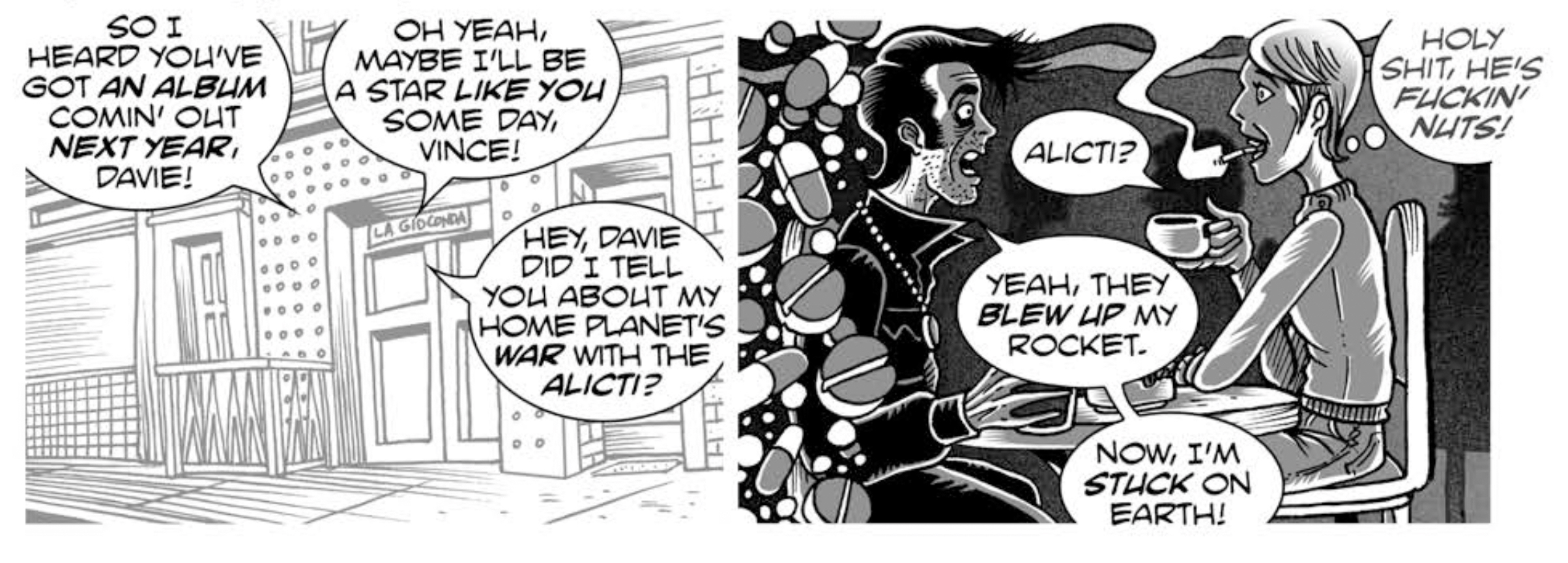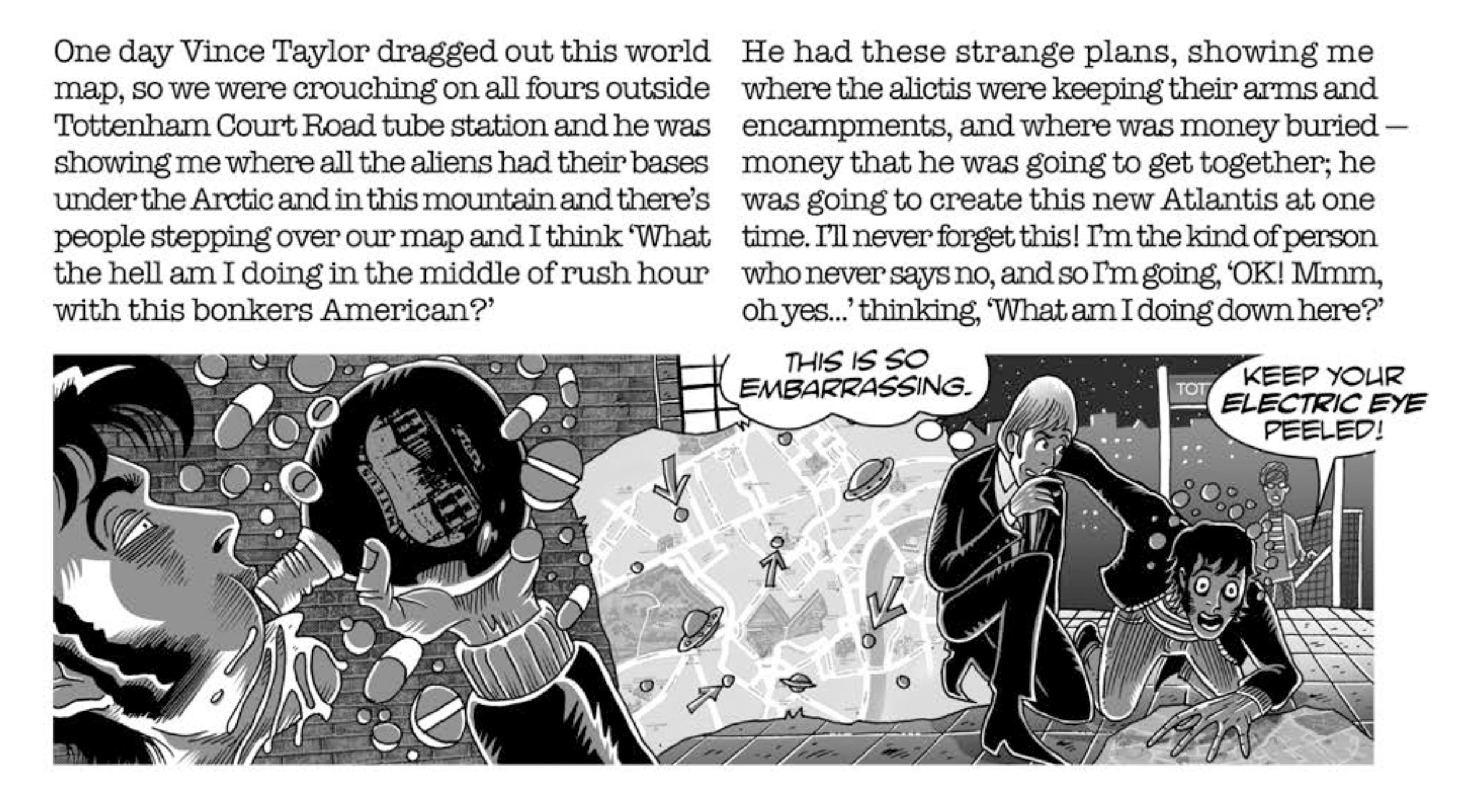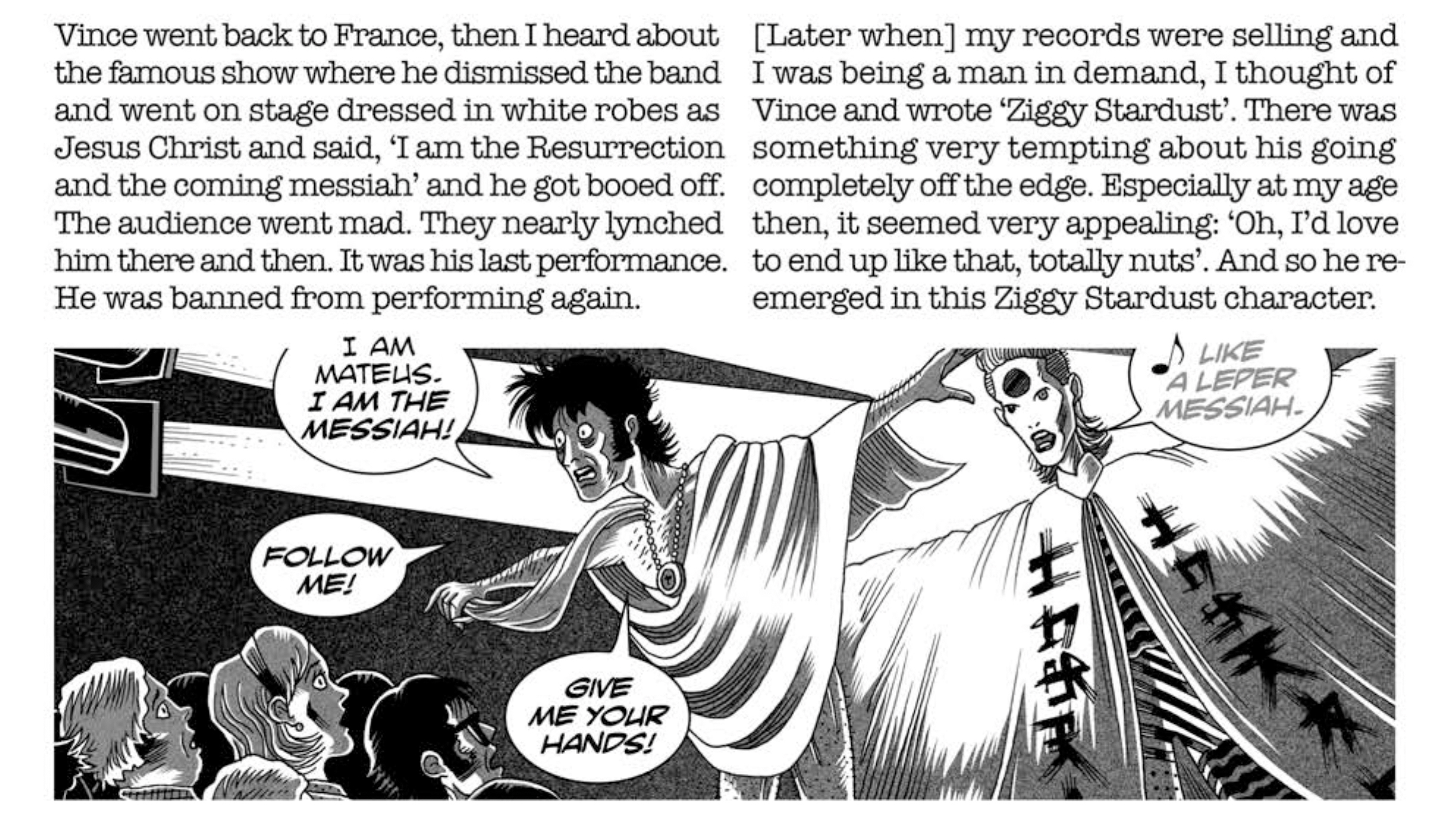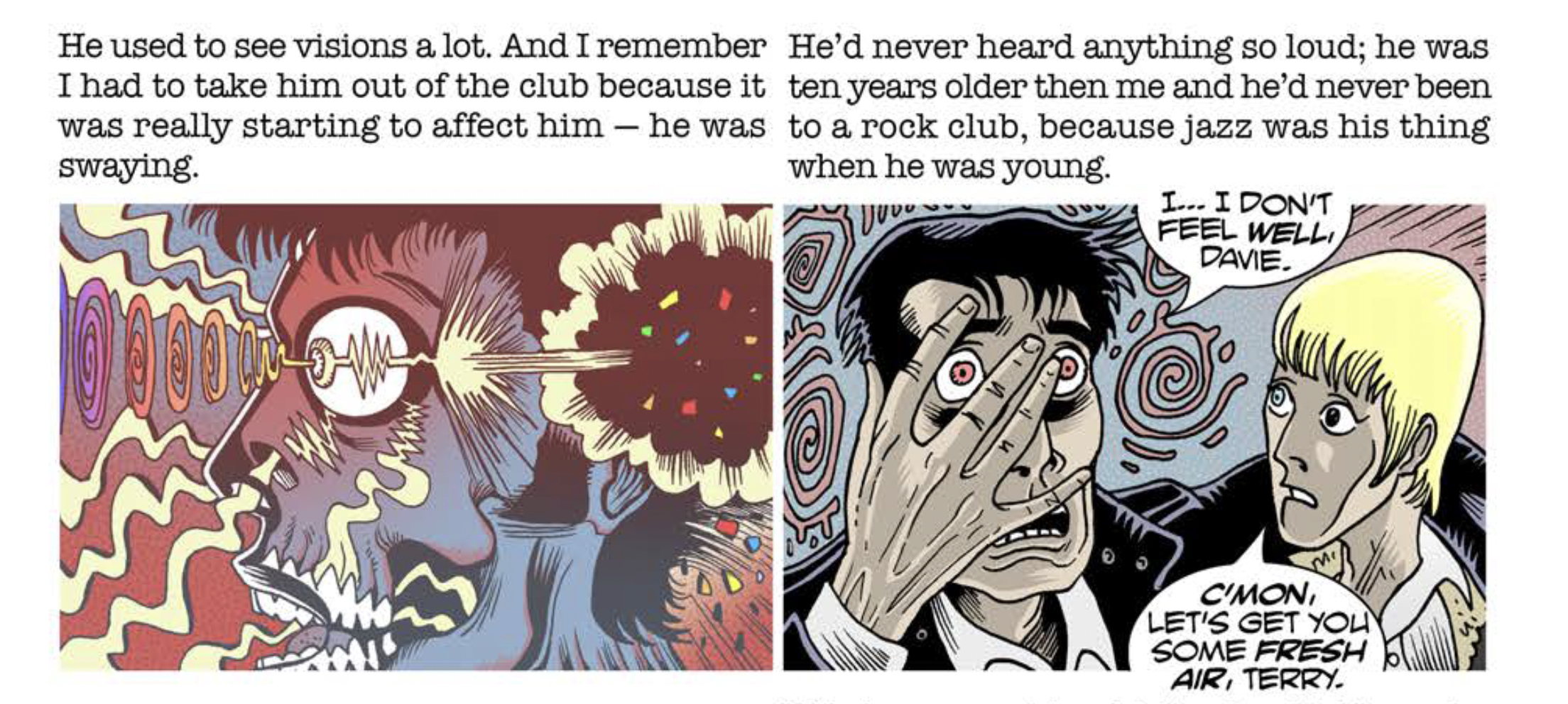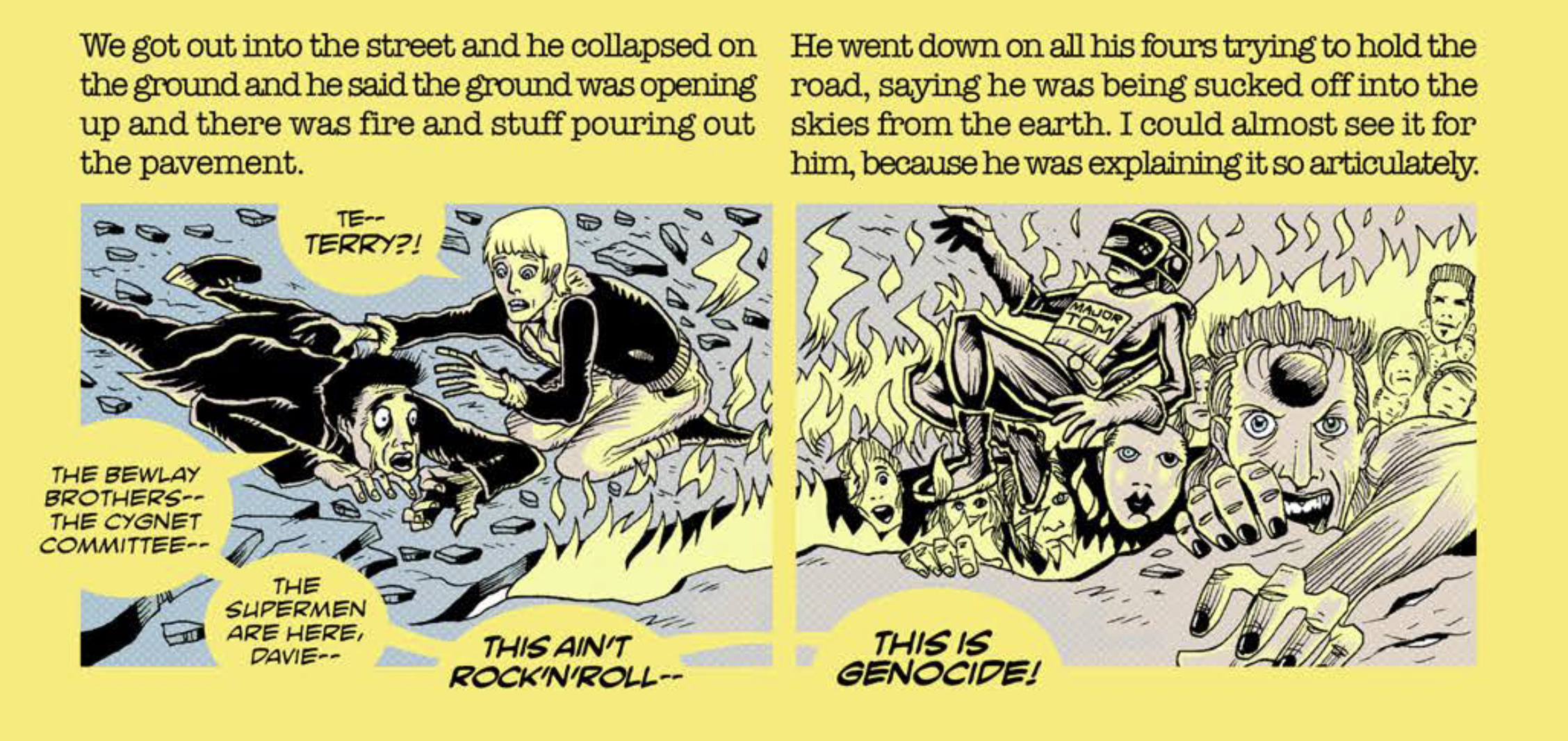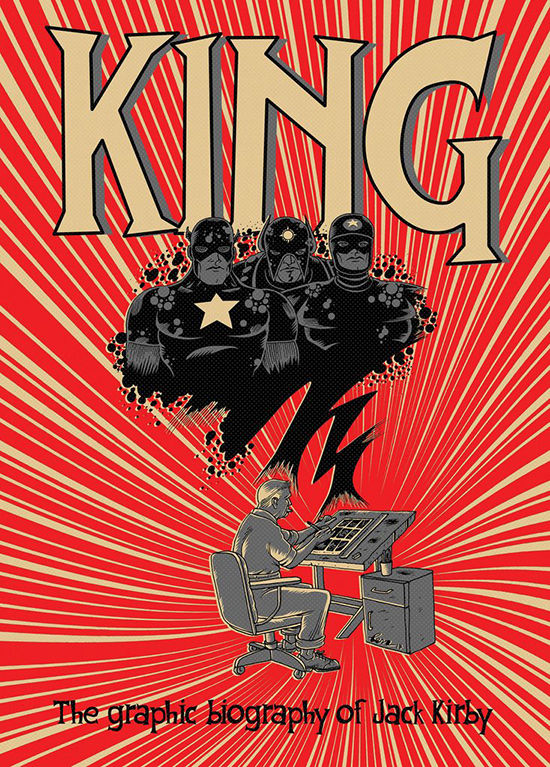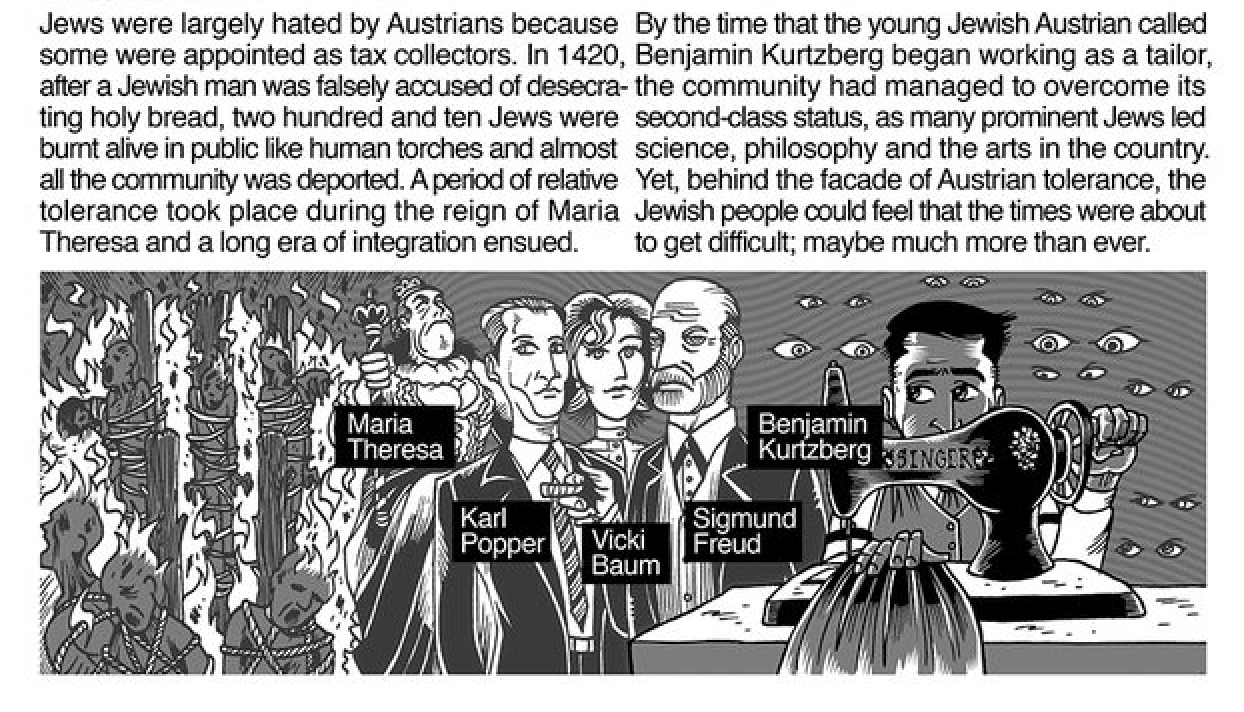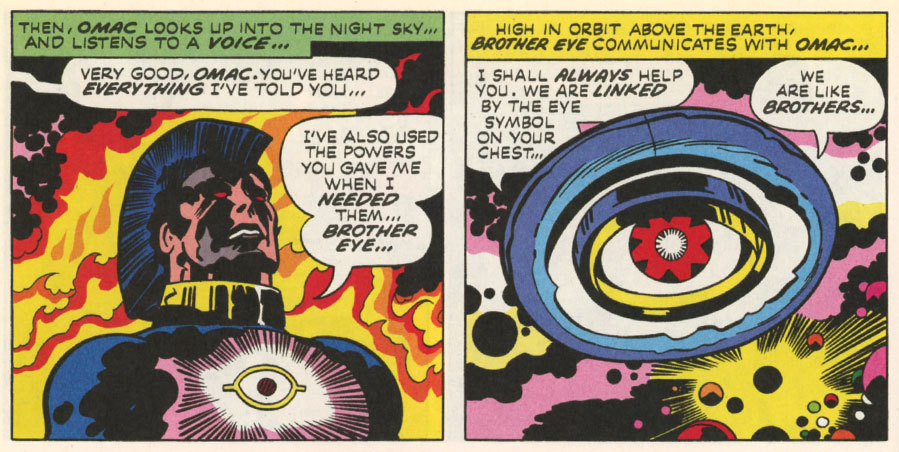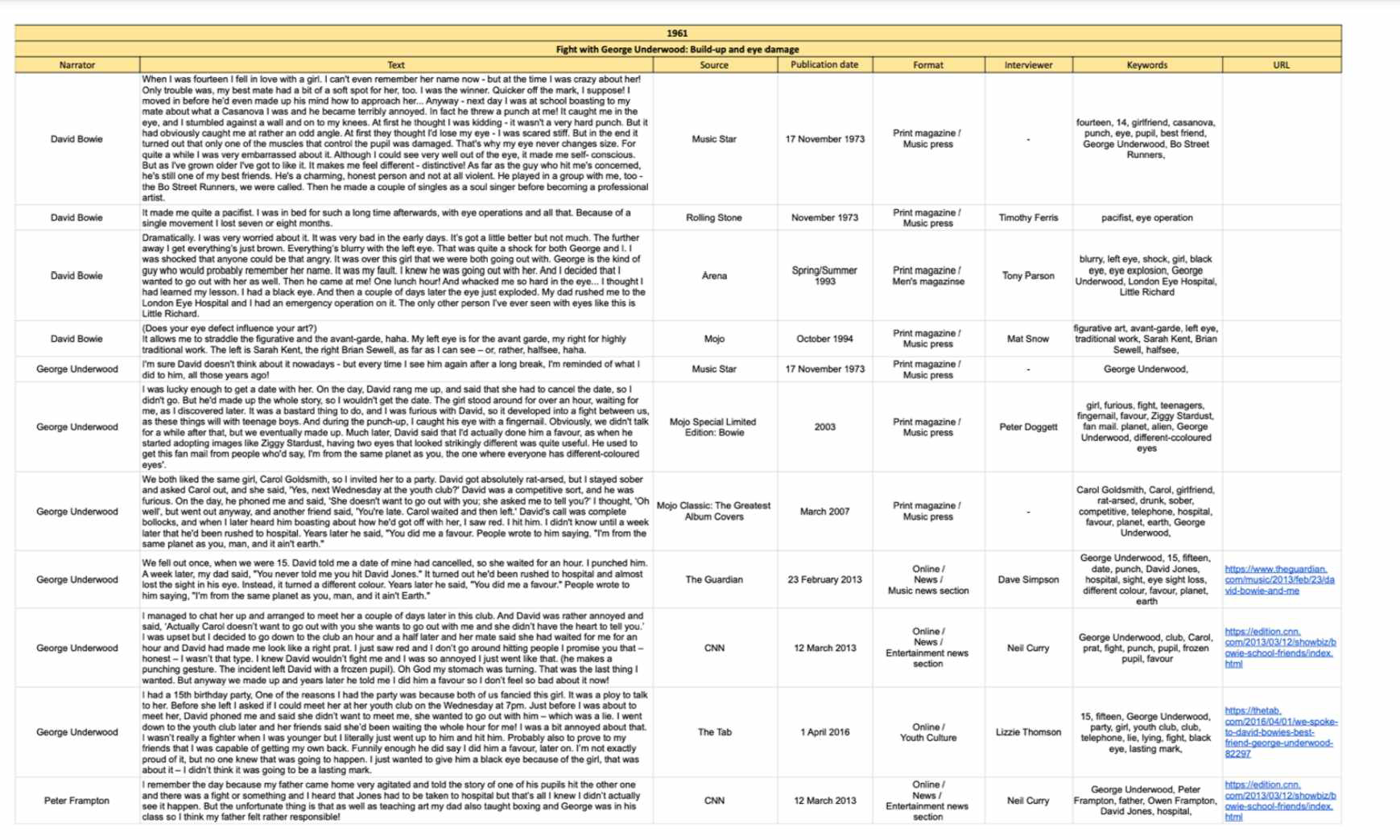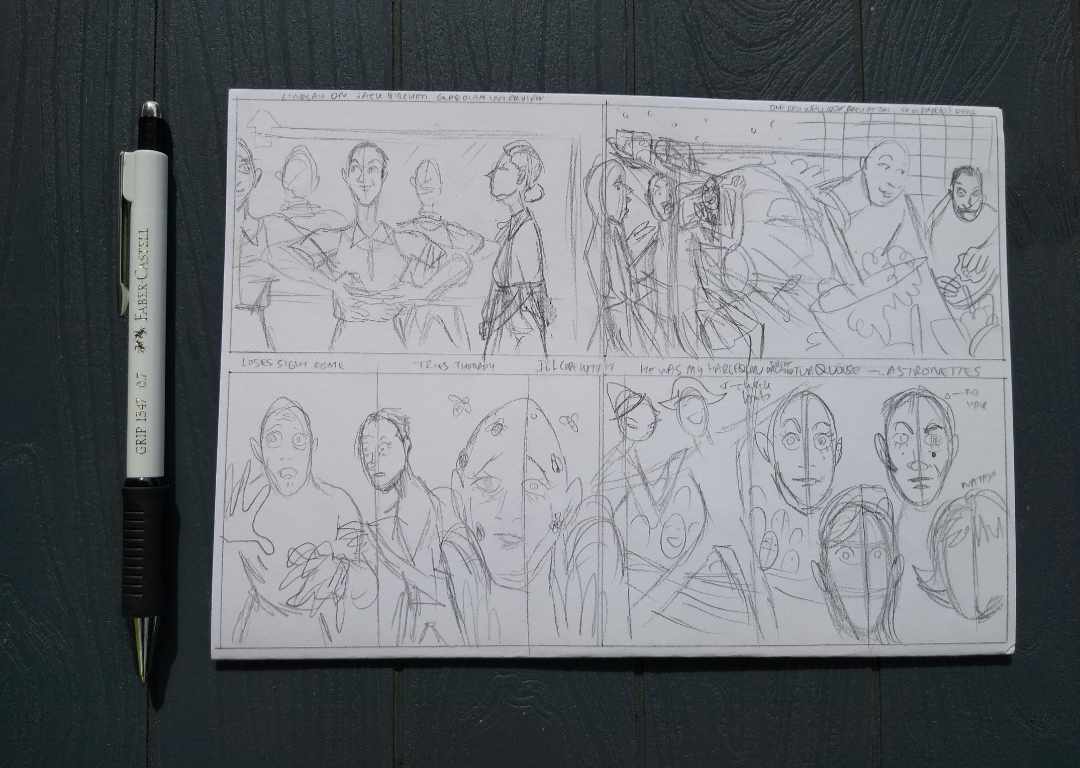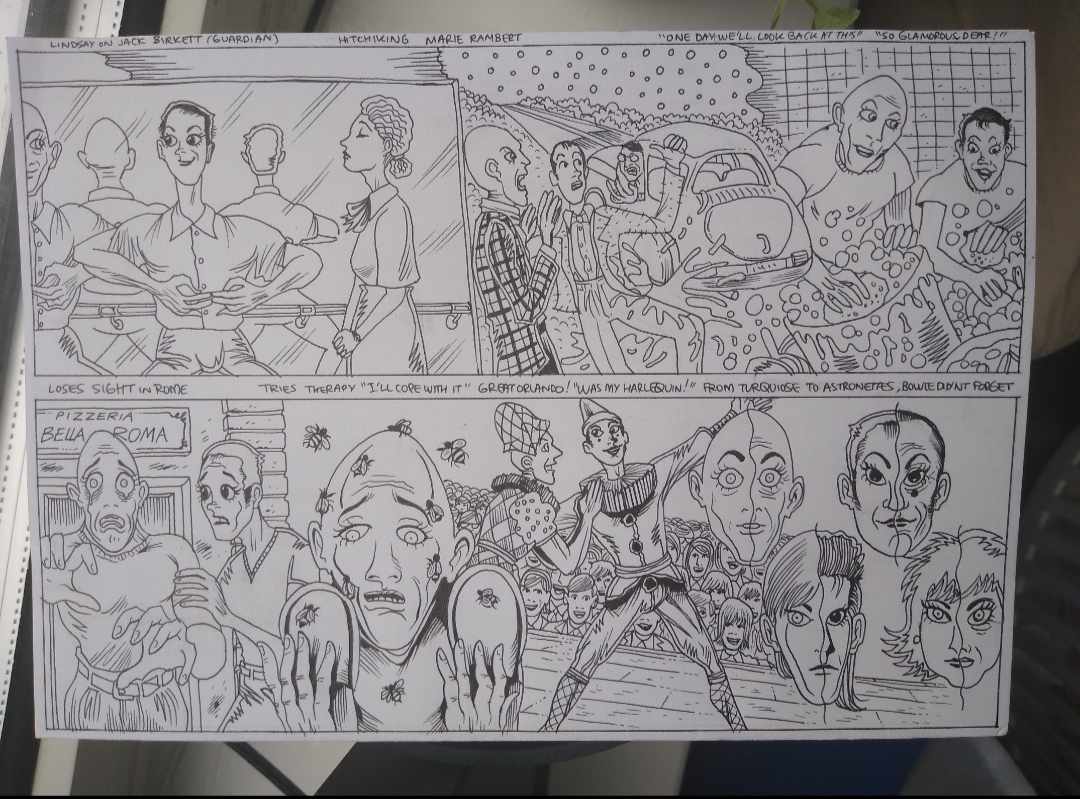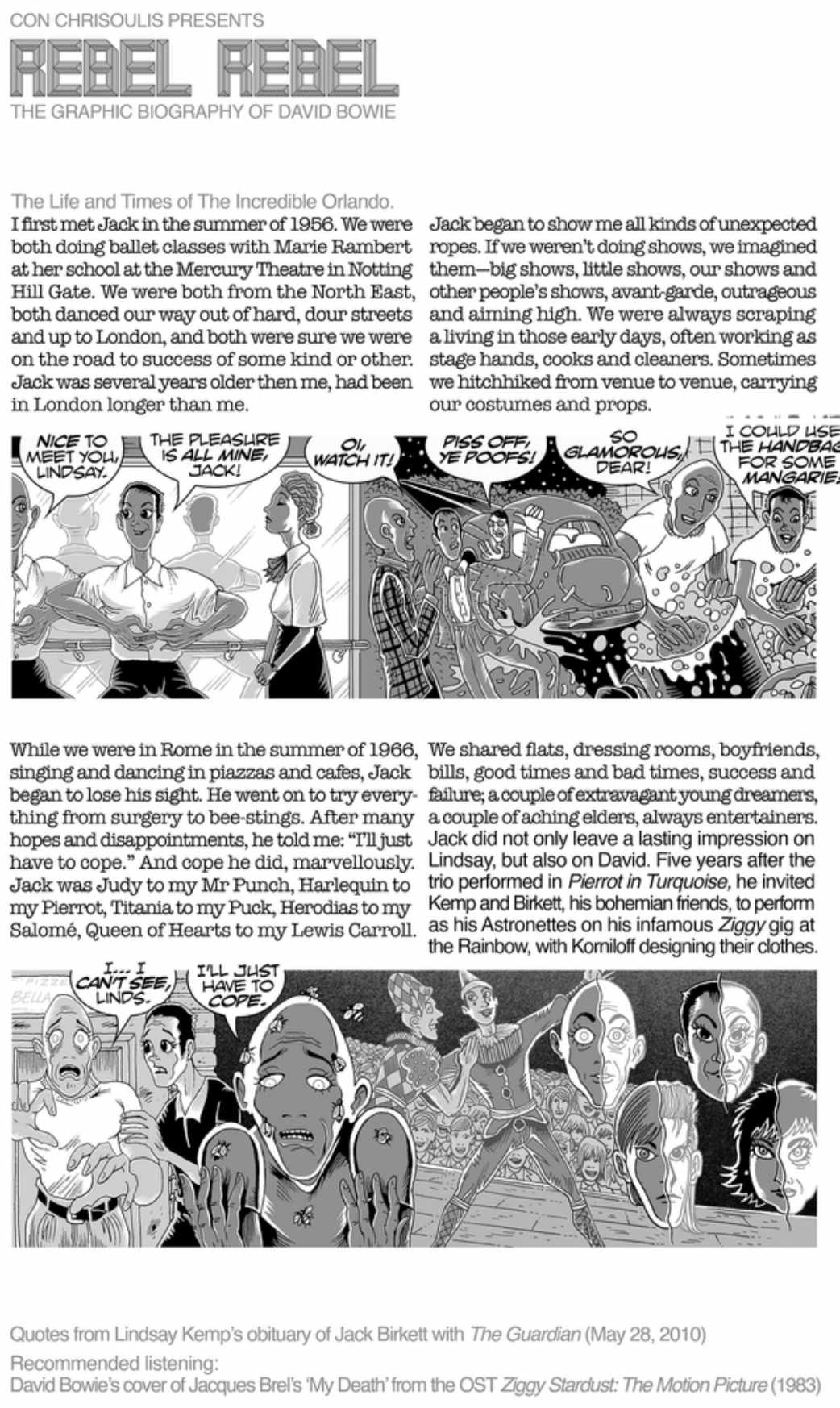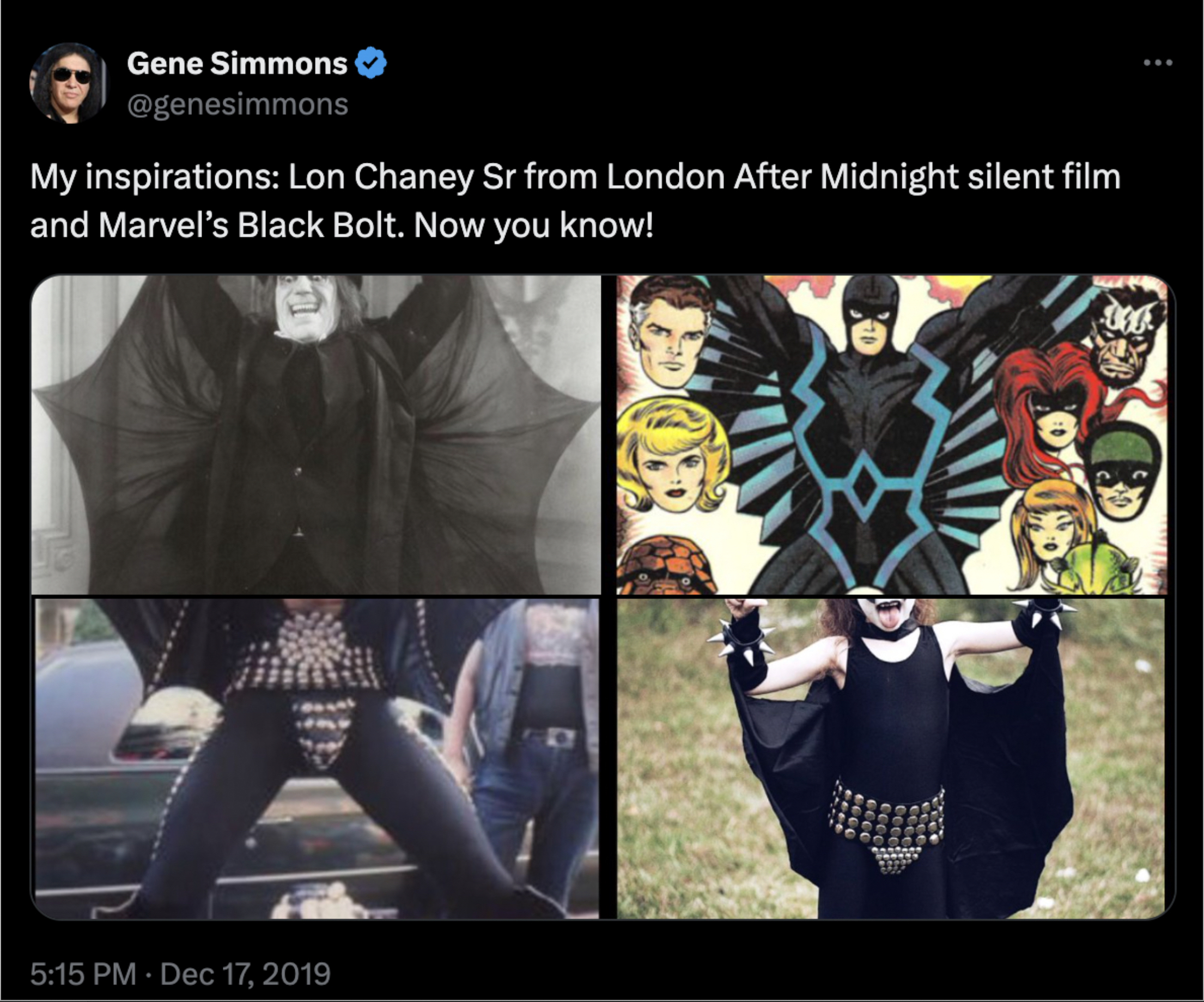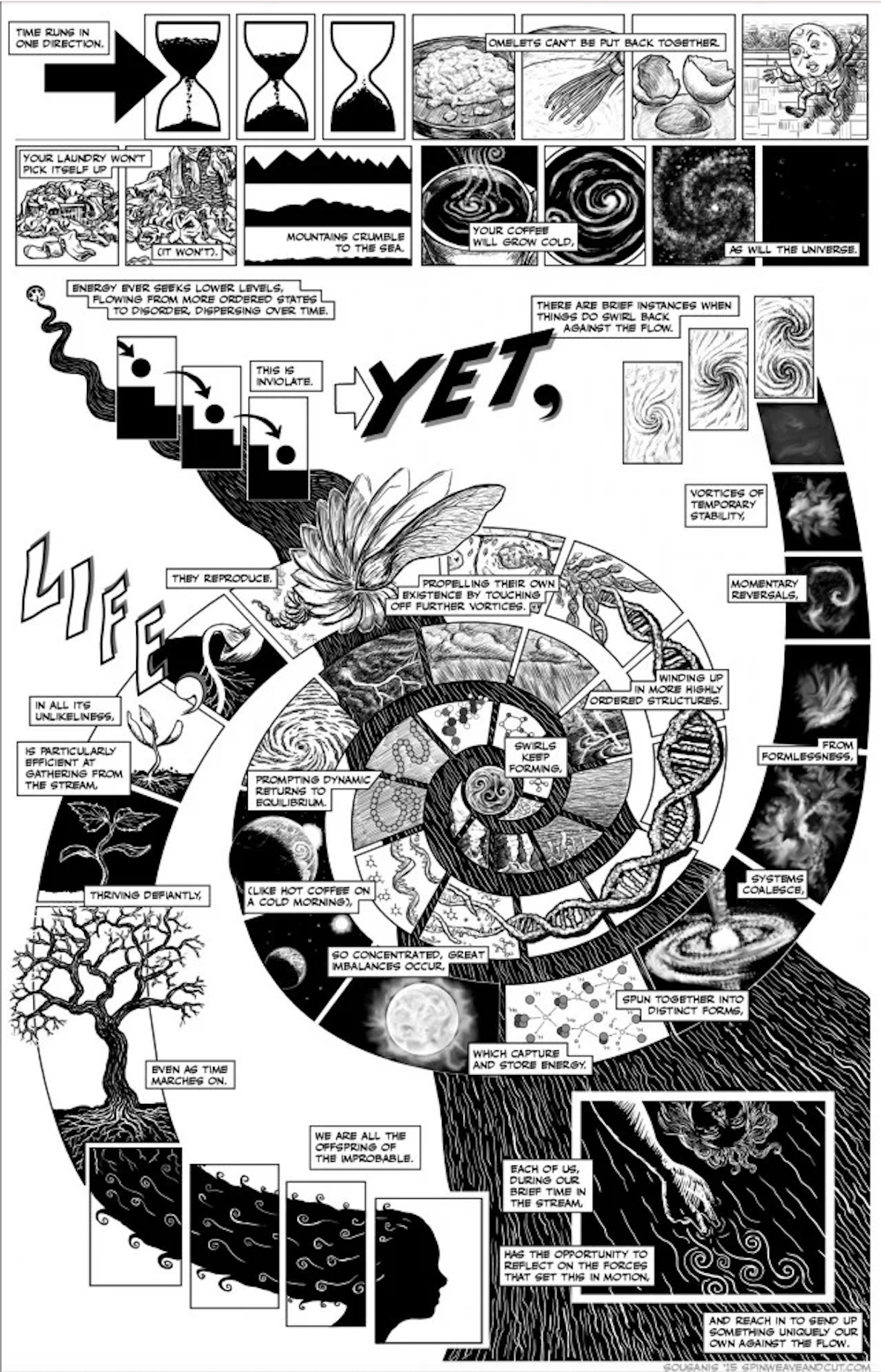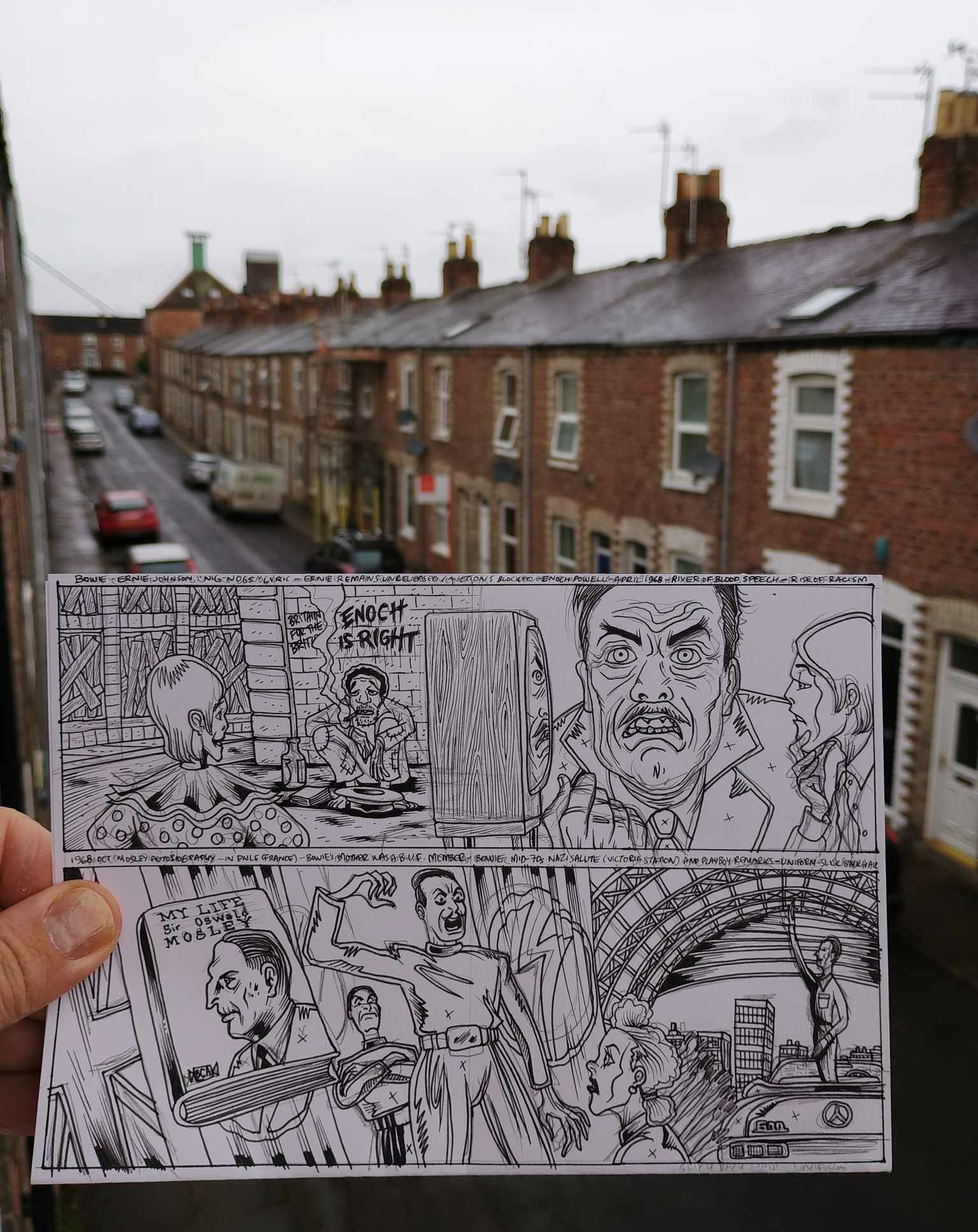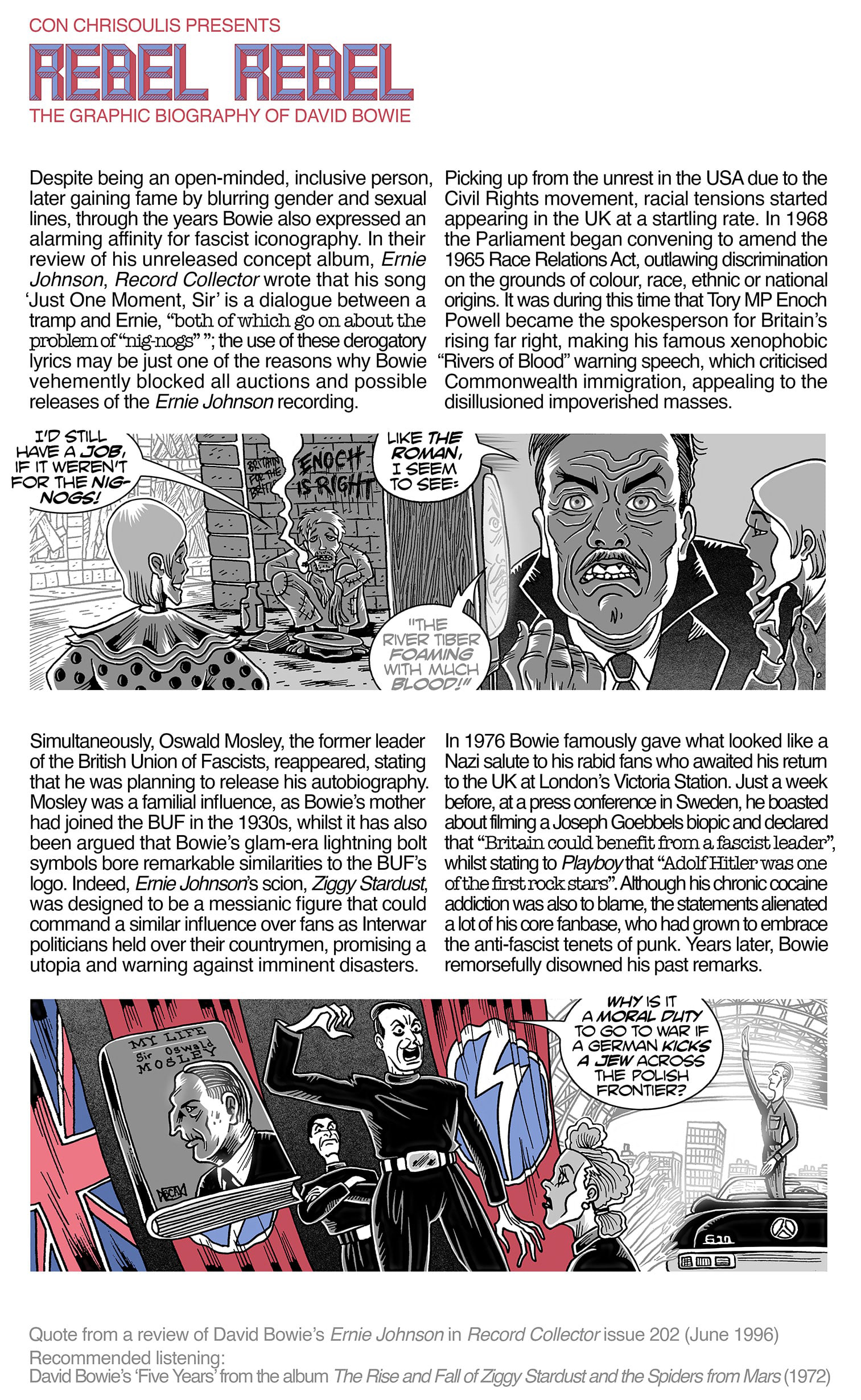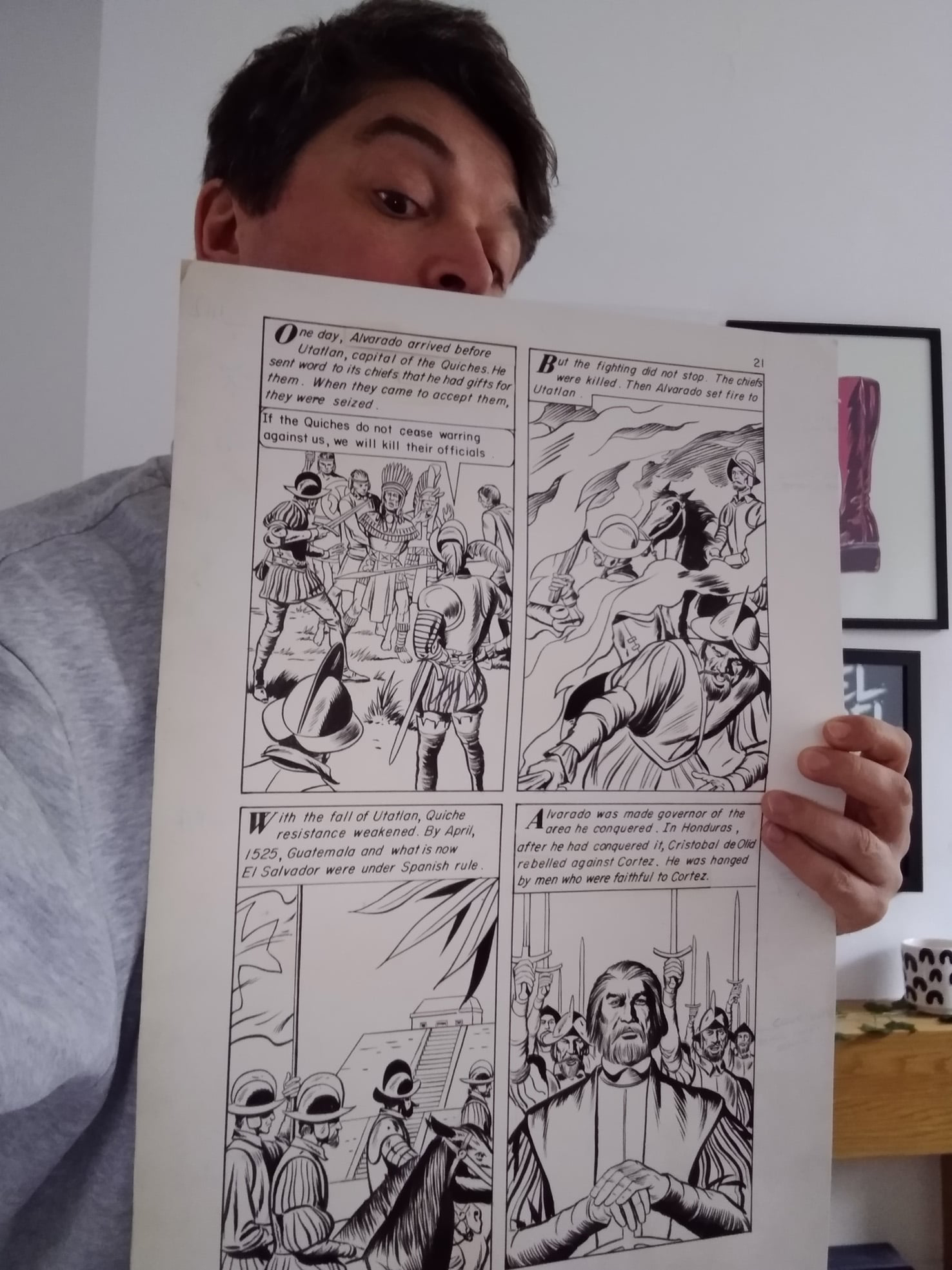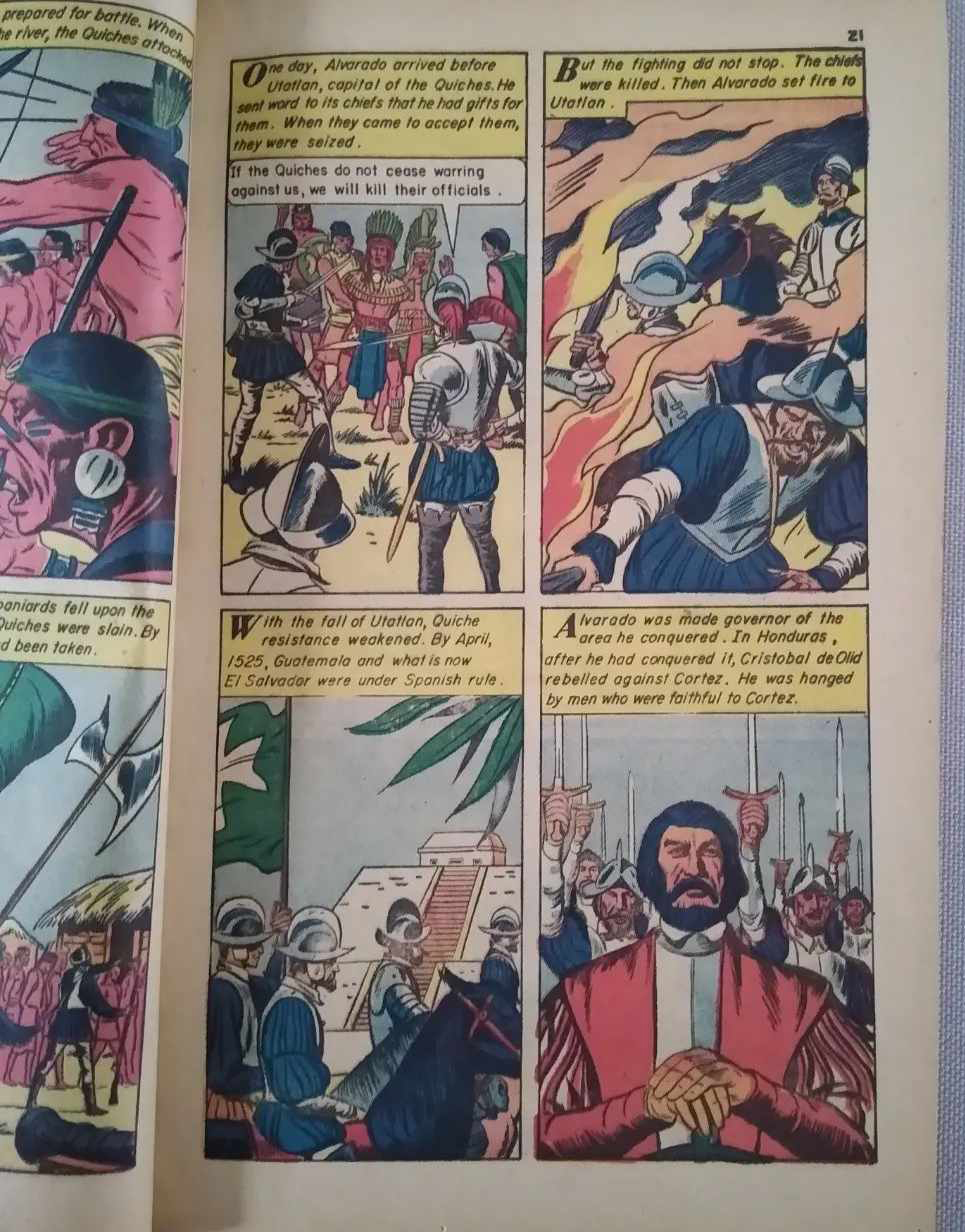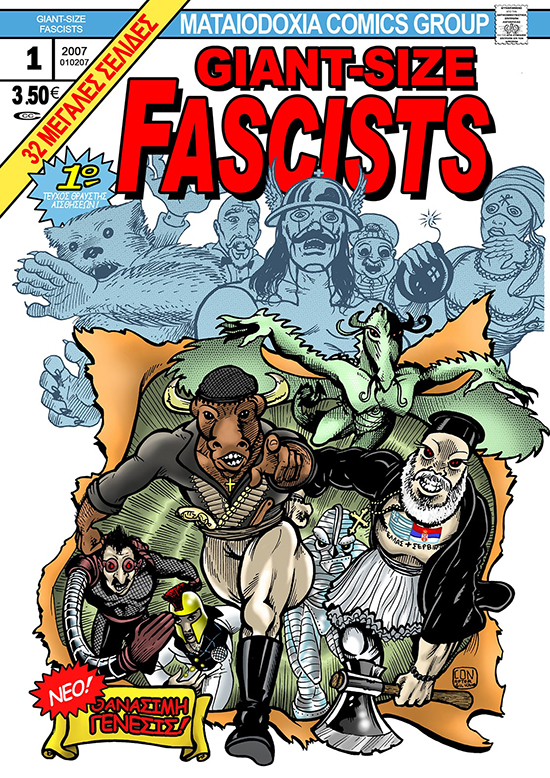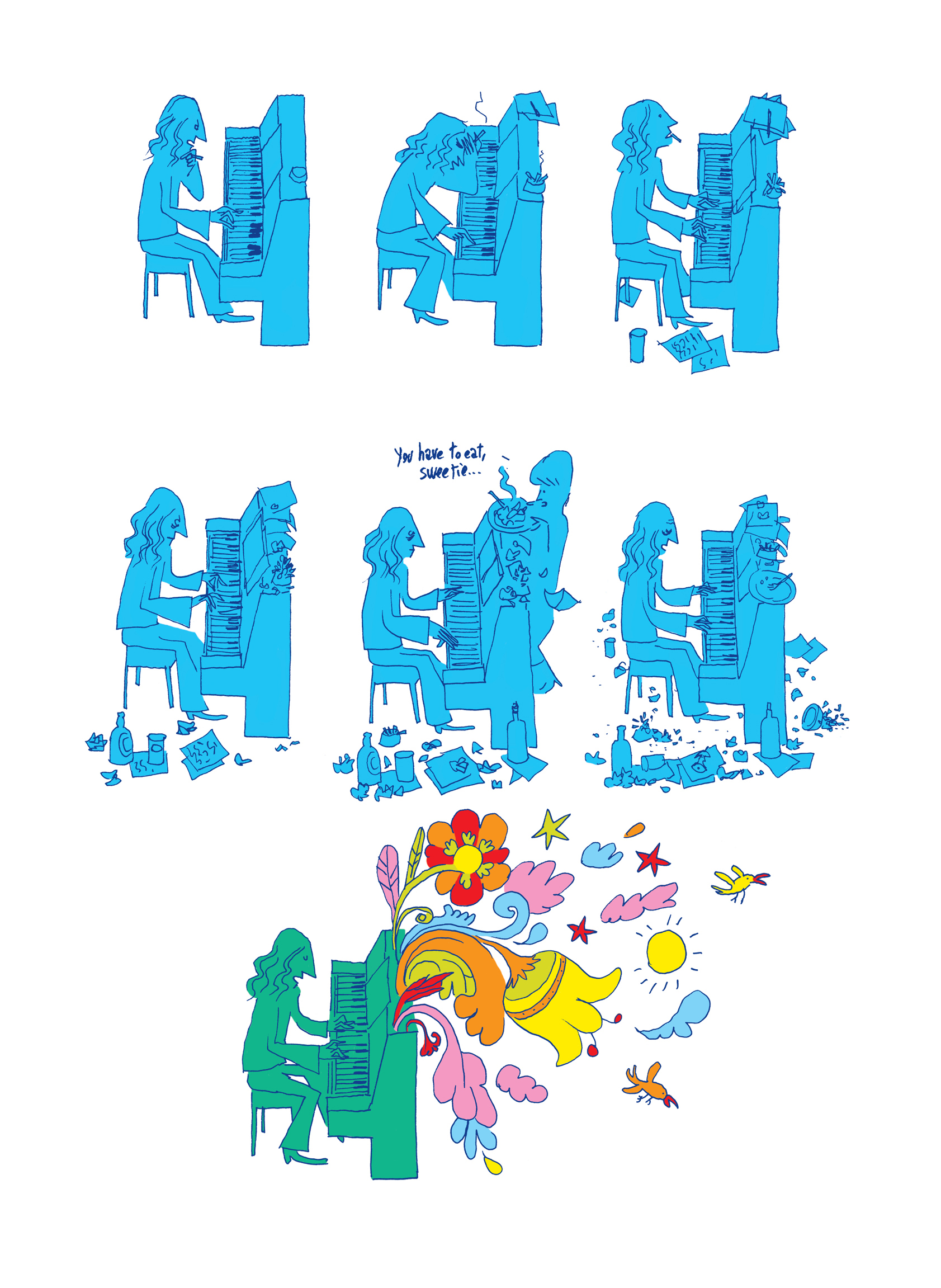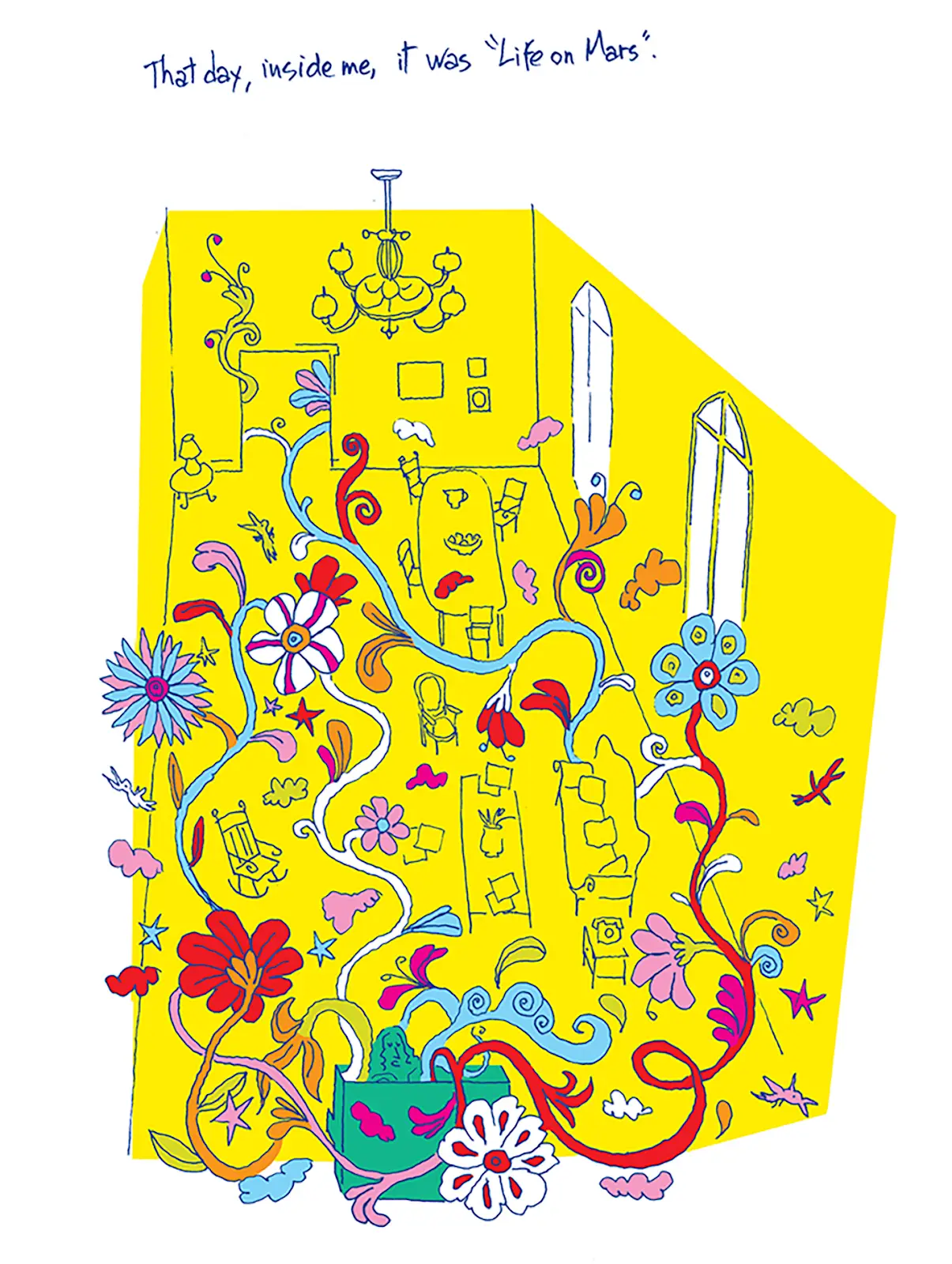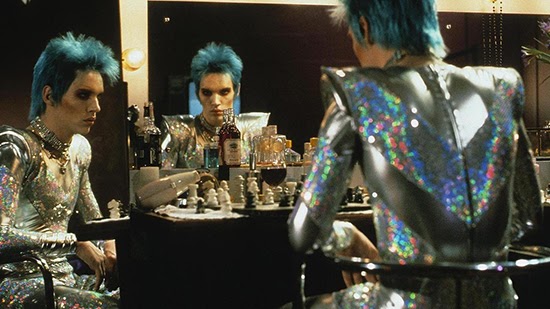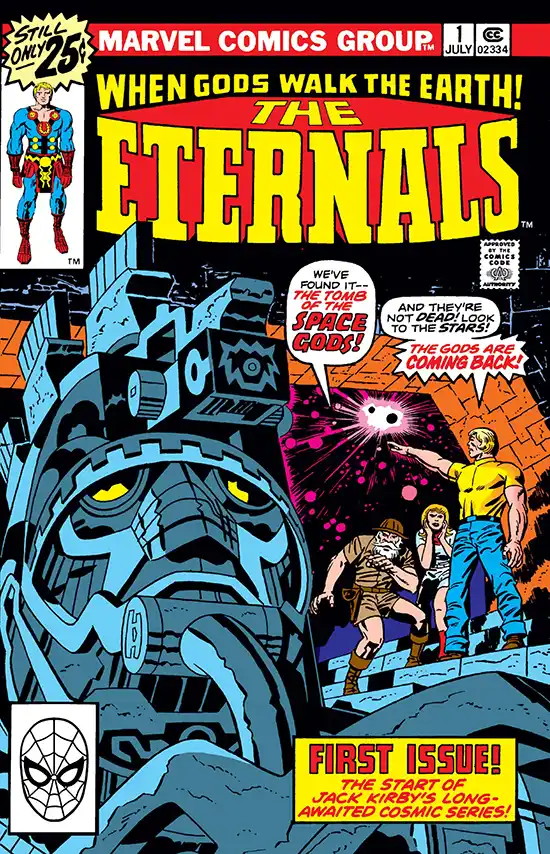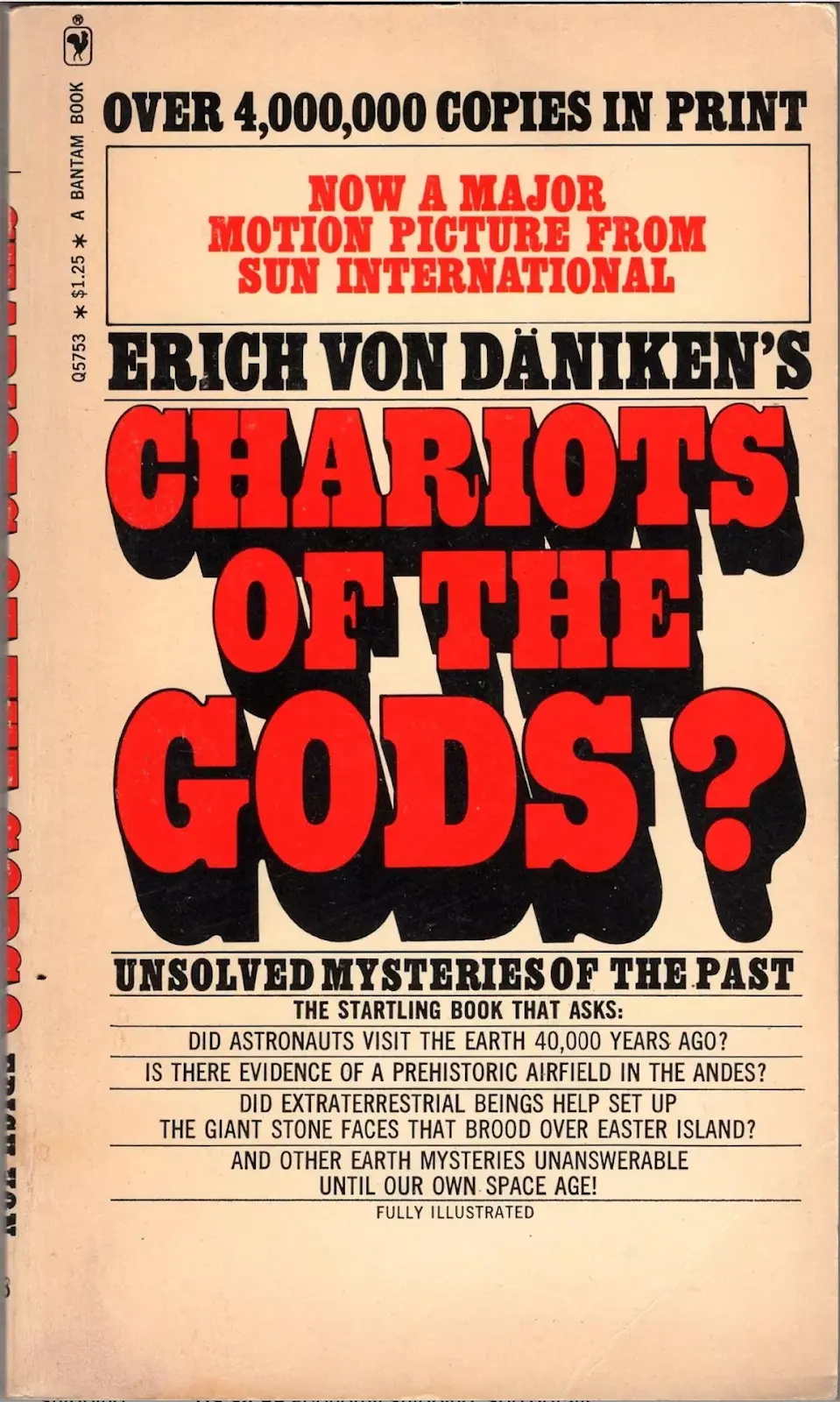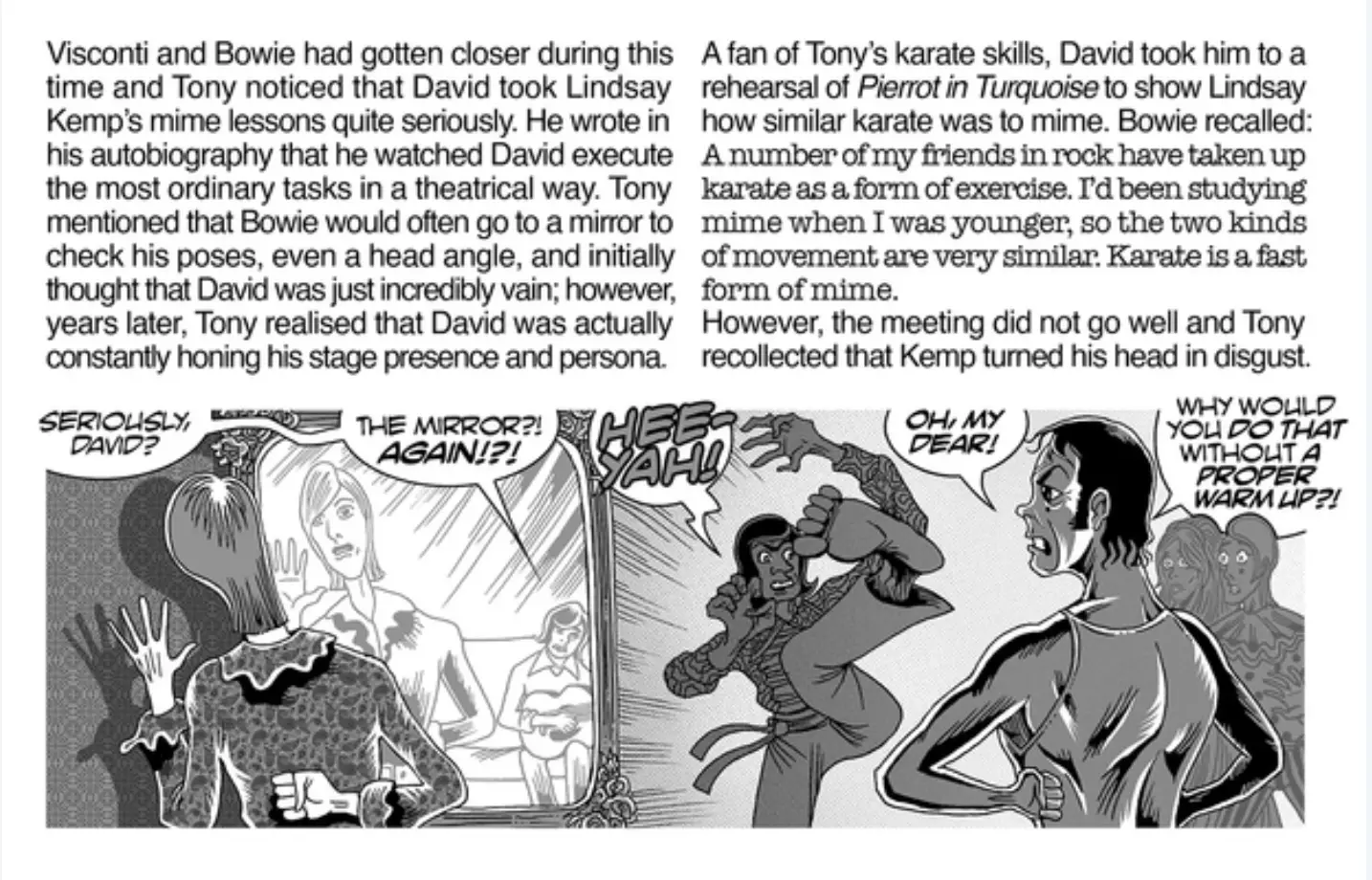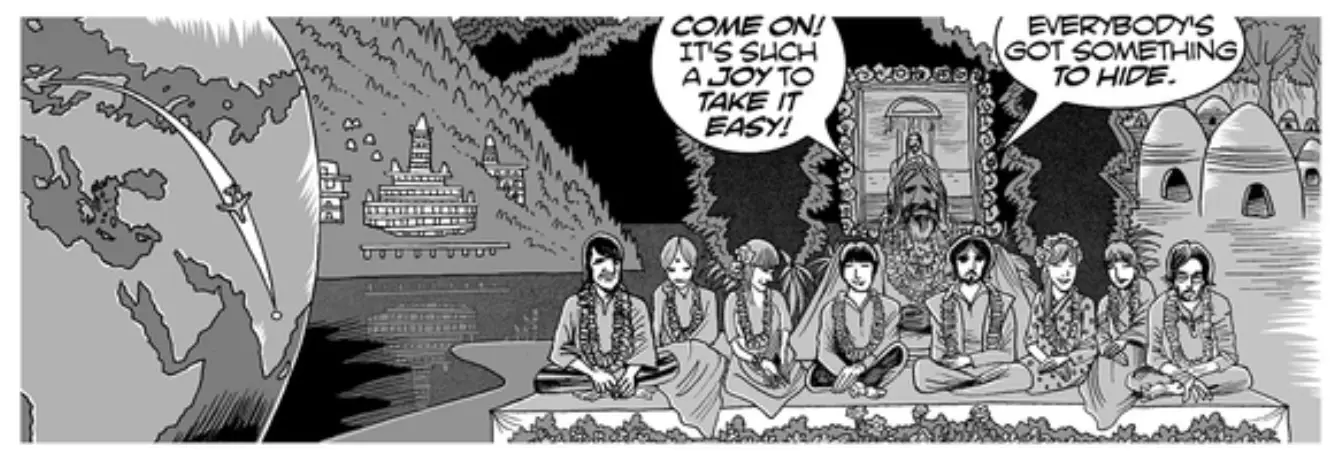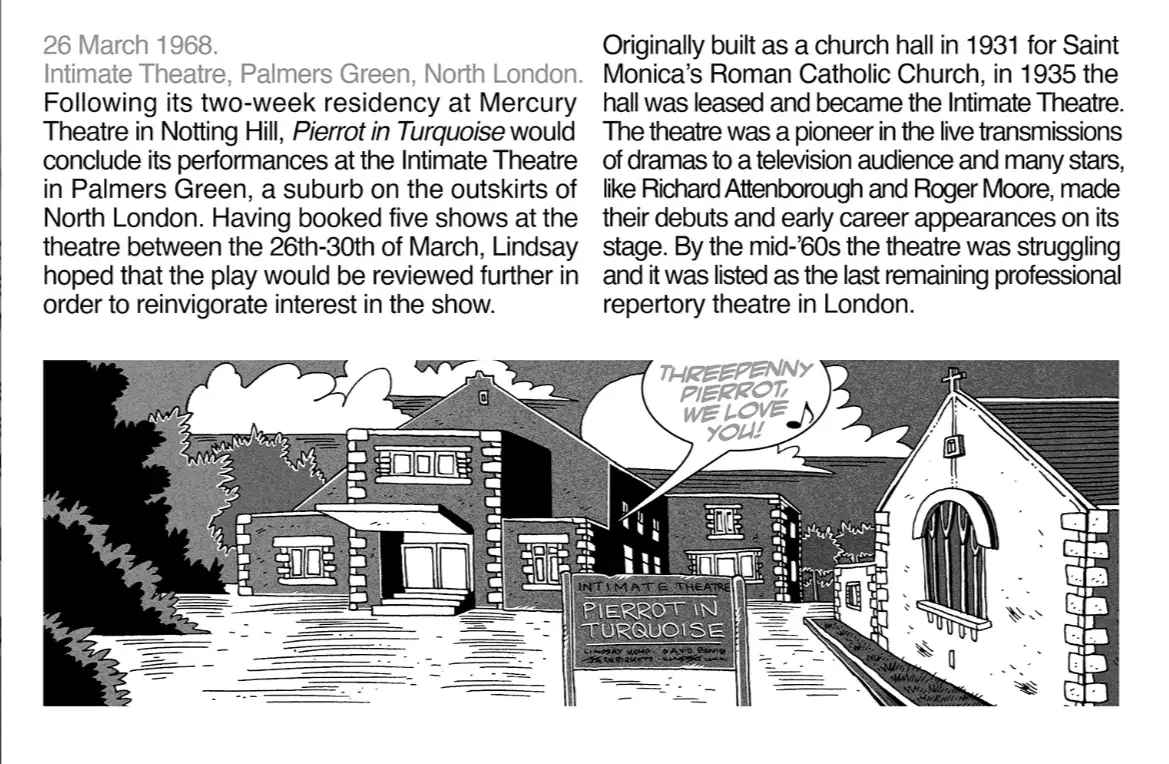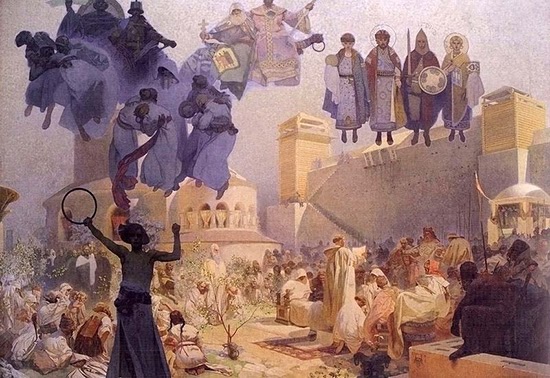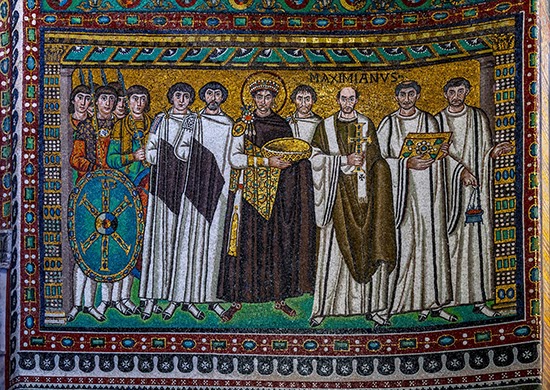OFF-TOPIC (63)
By:
September 19, 2024
Off-Topic brings you over-the-transom, on-tangent essays, dialogues and subjective scholarship on an occasional, impulsive basis. For this back-to-school time of year, an extensively annotated geekout with the kind of teacher you’d most like to pay attention to…
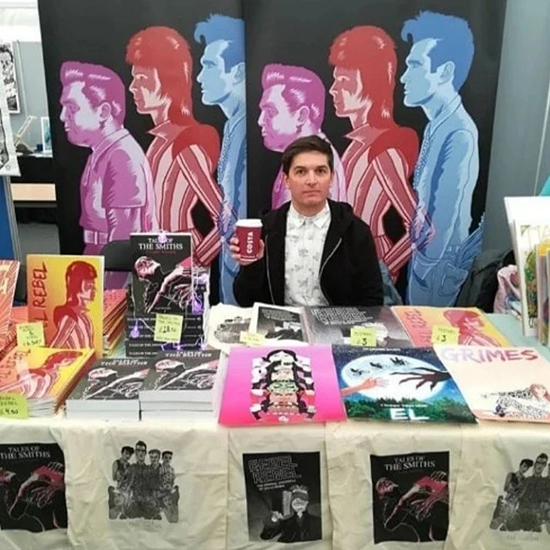
David Bowie could not dance. It’s a little noted, scarcely comprehended fact, and it’s not the point that’s most important: he knew how to pose. His reliance on choreographers, costumers and photographers was in service to the perfect moment, of gesture, attitude, expression; ephemeral seconds of his oeuvre and existence framed as art.
It’s why comics, with their sequence of frozen moments and imagined motion resonating between them, can be such a fruitful medium for his story. Artist and educator Con Chrisoulis has been reincarnating him in just that form, from birth onward (and actually somewhat before), in his ongoing online comic Rebel Rebel, and the cumulative effect takes on dimension and presence and inhabits space and fills in gaps in unforeseen ways.
Chrisoulis was previously known for his epic graphic biography of the Smiths’ formative years, available both online and in collected book form; those musicians, by contrast, are defined by motion, from obscurity to prominence and back like drummer Mike Joyce or guitarist Johnny Marr, or into death like bass player Andy Rourke, or of course from tragedian to wag, unknown critic to superstar practitioner, and ballads of outsider acceptance to spectacles of bigotry like Morrissey.
It turns out the Smiths could lend themselves to many a frameable moment too; Chrisoulis has put together a supercut of scenes from a 2017 Smiths biopic taken panel-by-panel from his comic. But those filmmakers didn’t do what Chrisoulis has done, painstakingly assembling from multiple sources to paint composite portraits truer than any single account could.
If you clipped daily comicstrips and articles from the olde-school newsprint that Chrisoulis’ style and artform homage, you’d begin to accumulate the four-dimensional understanding he’s achieved. His works merge the conjecture of archeology with the real-time oral history of the media (and then social-media) age, finding connections where no one might have been equipped (or attentive enough) to locate them before, and creating new resonances with the montaged, often muralistic compositions he uses to illustrate scenes and evoke context.
That panoramic scope yet close-focus perception matches him well to his other ongoing undertaking, a life of prophetic pop-art innovator Jack Kirby. It’s the first time Chrisoulis has turned his technique to chronicling another comic artist, and Kirby’s formative experiences, bleak, violent and filled with wonder, are as well-suited as Bowie’s suburban roots and surreal awakenings to Chrisoulis’ singular mix of fanciful verité.
Bowie and Kirby happen to be the twin pillars and binary star of my own preoccupations and creative path, so it felt like more than fan affinity and shared study that led us to cross paths and start a dialogue that began this past spring and goes public here…
HILOBROW: What is your PhD in?
CHRISOULIS: It is a PhD by Completed Work that I have been conducting as a Senior Lecturer at Teesside University, the work being the graphic biographies I have researched and published in the past 14 years. My commentary/thesis makes a case for graphic biography being a substantial genre of documentary comics, which does not get the attention that autobiography or memoir or comics journalism gets in comics studies. I discuss topics like the crossmedia aspects of webcomic graphic biographies (which is the original daily or weekly episodic form of all my projects) that blends sound and comics, remediation, reciprocity with readers, and much more!
[Note: Click on images for larger versions]
HILOBROW: The Bowie narrative is mesmerizing — I love how the blurb-length text and snapshot images work with each other; it’s not a straight illustration, it’s like an assisted association — the descriptions prime a certain expectation of what we’ll see, then the images open the aperture to dimensions we couldn’t anticipate but feel like they naturally follow…the text acts as our internal rational monologue and the drawn parts let in our sensory impression of what’s really fully happening.
This works especially well with the Vince Taylor sequences (where truth is even weirder than description), and the abilities of the medium are maximized there too, with the metaphorical wallpaper of pills and the advance-ghost of Ziggy hanging over Vince’s onstage breakdown. That layering of empirical and symbolic (Vince swigging while thematic pills float in the air), and stacking of space and time (the aliens-map forming a looming backdrop to the scene where it’s actually just a scrap of paper on the ground; Vince’s messianic outburst lapse-dissolving into Bowie’s dramatized/commodified version) are really pithy single-panel tutorials on all that comics can achieve.
I don’t think I’d read the account of Taylor unfolding his map on the sidewalk for Bowie to crouch down and confirm; it eerily reminded me of the anecdotes about [Bowie’s half-brother] Terry seeing the ground open up — I was very intrigued to compare this to how you would then visualize that, and of course it climaxes this volume and I should have realized that was what I was seeing a variation of on the cover.
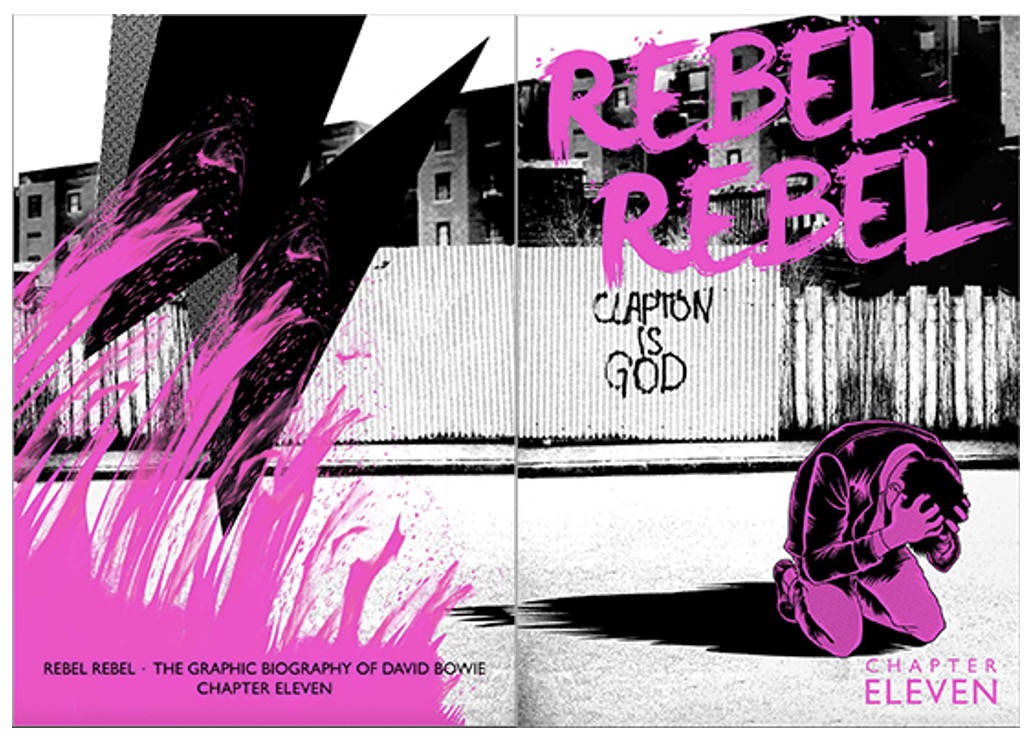
That cover is an understated masterstroke (the spare, indelible composition of the London Calling album art comes to mind); the stark markers of the story that’s more widely filled in elsewhere, not to mention the insightful friction of elements (an invocation of Clapton’s godhood looming over what could be a praying pose; the fires of creativity opening up at the touch of an unseen black lightning bolt; the roaring silence of this dreamlike empty street).
Did Vince really mention an “electric eye”?? I’m sure you used, ahem, prophetic license for Terry’s quoting of future Bowie lyrics so was curious… though even if un“true” in both cases it’s a bold injection of magicality into a factual account; faithful to the unreliability of all personal memory let alone celebrity legend, and the kind of interpretive time-travel I think Bowie (and definitely Terry) would have approved of.
The Kirby comic is compelling too — I’m astounded at how you trace threads from so far afield in world history and draw them up into the fabric of this one life’s storyline (which of course in turn so reflected and influenced the times around him and the future beyond). I like all the horizontal oblong panels — conveys a great muralistic aesthetic and cumulative narrative power, very appropriate to the century depicted.
CHRISOULIS: I was blown away by your analyses; working at breakneck speed to produce the weekly webcomics, I barely get time to revisit and reflect on my processes. Having said that, I had to, contradictorily, recently reflect deeply on all my graphic biography outputs for the needs of my PhD by Completed Work commentary. A lot of the plot decisions I make are products of a Stanislavski-type “method-writing” process through which I try to channel the subject’s actions following a lot of thought, predesigns, research, etc., and, despite going through a thumbnail process before each page, the visual outputs are definitely tied to the speed with which I need to work.
My current tendency to narrative through “blurb-length text” and oblong panels (avoiding several gutter spaces) is a fairly recent practice and is something I am currently contemplating; it may be an unconscious homage to tapestries, which could be considered precursors of comics, or the Greek Orthodox iconography that I was exposed to when I was younger.
No, Vince Taylor did not mention an “electric eye”, but he thought that a Big Brother/OMAC-type spaceship followed him around, so traces of that lyric are there PLUS poetic license. The panels themselves carry more info than could be unpacked in the already text-heavy captions. For example, Vince obsessively drank Mateus wine, which inspired his messianic alias!
HILOBROW: Hearing you describe your process as hurried is as surprising to an admiring fan as it is fascinating from a technical standpoint: I now see you as essentially emulating the creative reflexes of the classic comics producers themselves, working on deadline yet refining rather than rushing their craft (and inspiration). Would love to see some of your roughs; as I may have mentioned, I write comics (though don’t let me get near a pencil :-)), and that elusive element of “in-the-camera,” last-second perfecting of imagery is a perpetual source of wonder for me. (Come to that, I guess you’re emulating the Bowie aspect of creativity too, since he so often wrote in the studio.)
I love the way you manage not just to find associative threads within Bowie’s biography but excavate a clear but little-known Bowie-Kirby intersection in the Brother Eye reference! (Funny that, much later, Judas Priest would seem to be homaging OMAC in a song titled “Electric Eye,” though that’s probably just my fan-brain imposing an order on things :-).)
CHRISOULIS: I suppose a lot of the compositional processes become instinctive following years of applying the same methods, something that Kirby was well in tune with. Rebel Rebel is my fourth long form graphic biography, without break. Since 2012 I have followed the same process, daily, without break (I just calculated that it is about 1,200 pages): heavy quote-based research (see the attached spreadsheet screenshot of — just — the quotes surrounding Bowie’s eye accident), sketches and meditating on actions using a “method-writing” process, quick thumbs or straight to rough pencils and — much more time — inking. In terms of style, it’s the traditional inking stage and the digital zip tones that will determine the aesthetic. Don’t get me wrong, I teach the rule of thirds, camera angles — even Fibonacci — daily at the university, but the daily grind liberates one from rules, surrendering to (and trusting) instinct and muscle memory.
*The Judas Priest connection is a good catch. As a massive KISS fan, you will not believe how much the band owes Jack (Gene Simmons’ Black Bolt wings being the most famous, confessed, case).
HILOBROW: These evolutionary stages are priceless — and in the rough Rebel pages I see another connection to Kirby, with your margin-notes; intriguing to see how these prompts guide the action, how the action diverges from them, and how even the prompts themselves can morph, over the course of development, even with a single creator, when the disconnect between Kirby’s intentions and Lee’s interpretations is legendary (though in turn, this too puts me in mind of the duality of Bowie — the distance he kept between his creating and performing selves).
The daily discipline you describe casts light on a quality that stood out from the start of reading these, which is that, rare among prose and perhaps unique among graphic biographies, these truly are chronicles — every minute from start to finish of the lifetime in question (indeed, from before the beginning, as Moz might say, since your Kirby book starts in Austro-Hungarian history) is recorded, as opposed to books like Tom Scioli’s own Kirby, and especially Lee, biographies, which selectively shape the life story.
Btw your dictum that “the daily grind liberates one from rules, surrendering to (and trusting) instinct and muscle memory” is as good a golden rule for Kirby’s stylistic and storytelling stretches (and resulting aesthetic revolution) as I’ve ever seen expressed!
The invocation of Fibonacci reminds me of your fellow graphic scholar/practitioner Nick Sousanis; I assume you gents know each other? Agreed on the KISS connection though I admit I never even thought about the Black Bolt wings :-) — I’d bet you’re the most likely source to conclusively settle whether Kirby could have known about Sabbath’s “Iron Man” when conceiving of the Promethean Giants! :-)
CHRISOULIS: I have never met Sousanis, but Unflattening is a pretty classic text. (*I assume he is also of Greek heritage cause of his name and his upcoming work focusing on “nostos”.)
Yes, the margin notes are something I have been doing for ages and realised that Kirby did it once I started reading The Jack Kirby Collector! It helps me get back on track and gather my thoughts when I continue working on the page throughout the day! I draw most of my pages on folded A4 (so A5) which is very, very tiny, but it allows flexibility and portability, as I carry my pages with me from cafés to trains on commute to park benches — anywhere! It’s mad, but I have illustrated all the pages everywhere except a desk, as I am always on the go. I will attach today’s page below!
This reminds me, I will send you pics of the original pre-Marvel Kirby page I have, which is on a non-fiction subject; the output is presented with a similar text-image ratio. Once I saw the page, I thought it was fate and bought it.
Today’s page (Enoch Powell, Oswald Mosley and Bowie flirting with fascism as far back as 1968):
You will notice here that although both “panels” are wide-screen murals, in the pencilling stage I have ruled a vertical line in the centre to separate the action. This is made even more clear by the blocked texts in post-production.
Here’s my Kirby page from The World Around Us issue 32 (April 1961):
It deals with a non-fiction subject (Hernán Cortés and the massacre of the Aztec people). Notice the blocky captions and the text-image ratio. Though gutters are there, the pacing is not communicated via sequenced gestures/actions, but through the text wording, as the panel contents are mostly static and there’s a time jump from panel to panel. *Another interesting tidbit: Kirby wrote notes in the margins of his original art even when he was not working with a steady collaborator like Joe Simon or Stan Lee.
HILOBROW: My mind is blown at the compact scale of your originals; the better to condense your vast orchestration of ideas I guess, though given that scope I would have presumed a broader canvas. The have-travel, will-draw aspect makes perfect sense though (and helps fuel a fine making-of legend!). When I used to do visual art I tended to pine for the lost perfection of my initial sketches; was I just suffering from what Jeff Rougvie calls “demo syndrome” or do you find this method allows you to preserve some of that first-thought-best-thought spontaneity?
How fateful that you evolved the Kirby margin-technique independently (and I was not aware that he left himself these notes even when working solo… and to think I’ve written for the Kirby Collector since 1997 and overlooked such an item…)
I joined the Patreon and can’t wait to see this completed episode — another equivalence between Bowie and Kirby that I have pondered before is that no other two artists come to mind whose archive seems so endless… whenever you think you’ve seen every Kirby comic & image or heard every Bowie track, another project comes to light; it’s becoming a theme of this message, but how I never heard of Ernie Johnson before now mystifies me (it would have emerged around the time I was playing my advance Earthling cassette to ribbons [in my music-journo days] and was thus distracted perhaps).
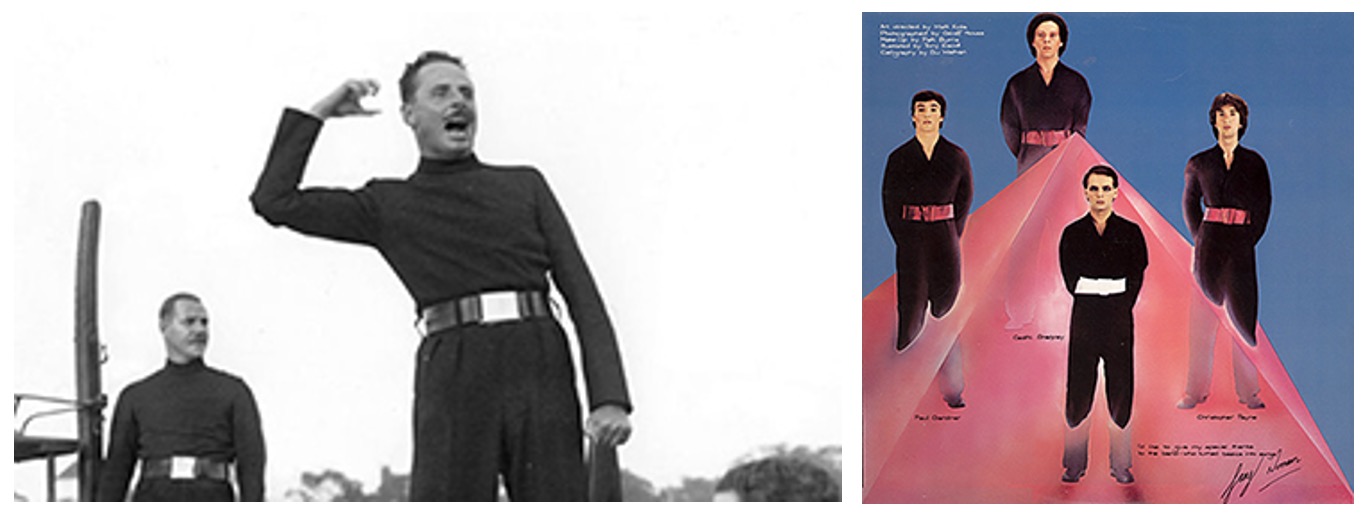
So Ma Jones was a BUF [British Union of Fascists] member — wasn’t Terry’s dad Jewish?? That Mosley pic was so unbelievable I knew it had to be real, and of course located the reference photo online… those big-belted jumpsuits put the costumes of [Gary] Numan and his mates on the inner-sleeve pic of The Pleasure Principle in an eerie new light.
Great stylistic serendipity with that nonfiction Kirby page, though dare I say it I like your dynamics better :-)…
CHRISOULIS: Many thanks for joining the Patreon, Adam! I hope you enjoy the older and upcoming episodes! You can now scroll down endlessly and access episodes #90 onwards (there are currently more than 400 episodes on Patreon). You can read episodes 1-25 on Webtoons (which I tried my hand at for a bit, but its format wasn’t for me)! … In the initial episodes, much like my Kirby book, I delved into Bowie’s ancestry. There you can also read my initial research on Peggy Burns’ (David’s mother) BUF membership and her affair with Terry’s dad, indeed of Jewish heritage.
“Demo syndrome” is an interesting feeling. It intrigues me only when trying to demonstrate my process to others, otherwise I don’t mind losing this part of the process to the inks, which better reflect my final intention. Having said that, I have started working with blue pencils recently, which don’t need erasing when scanning, so some of the initial drafting may be finally preserved.
Video of my blue pencils whilst drinking coffee when I visited Athens a couple of weeks ago…
HILOBROW: I like the bluepencil, grants a nice serendipitous Edward Bell palimpsest quality. Much enjoy the Webtoons era too — you adapted to the dramatic rhythms of the vertical reveal with great instinct and imagination (I started at relative random with the Bromley ep, #16). Great insights to admire each time I rummage… cool to see the condensed historic timeline from Migration Period to Windrush Generation (ep #13), and had not known (#14) that Bowie & fam had a nomadic course like mine (at least partially — I’d lived in 11 different houses/flats by the time I was 18).
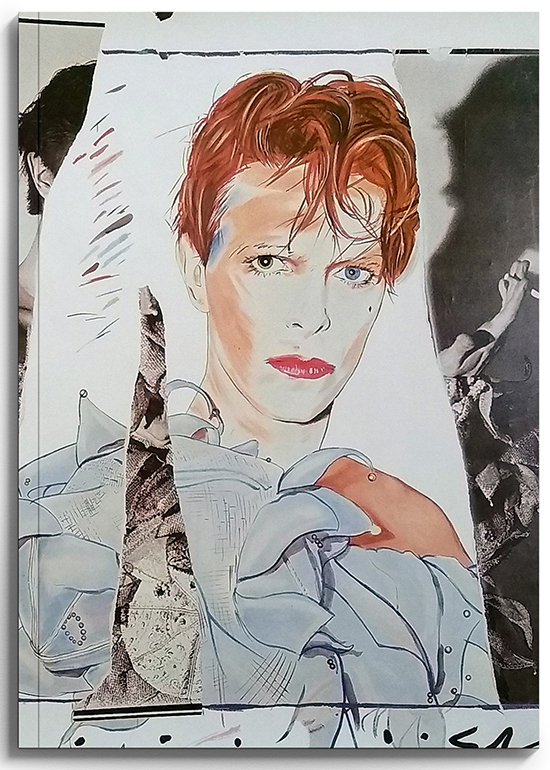
CHRISOULIS: Glad to hear that you enjoyed the Webtoons episodes, Adam. It’s a peculiar platform that does not lend to easy reformatting for print, just another reason for me to stop posting it there as well (the print editions for Lore Olympus, Webtoons’ champion title, have suffered greatly from the switch from vertical scroll to traditional printed page). Unfortunately, the infinite canvas that was lauded as the future of comics has massive drawbacks for people still wanting a tangible experience — see: the resurgence of vinyl records!
I see you’re a fellow nomad! Yeah, I’ve been all over too. All over Australia, all over Greece and now all over the UK. It does wonders to the creative brain!
HILOBROW: It may be that the “infinite canvas” ends up as just an optional format, or turns out to be a separate artform… iffy though, when everything is designed as marketable in any medium… though on the third hand, with phenomena like NFTs the online space keeps trying to re-create the uniqueness and scarcity of a limited-run card, print or comic, so maybe there’s a future for online comics that stay online (which could be fine for publishers while no advantage for the creators who need something they can prove they did and that people at comic-cons can hold and buy… my friend Dean Haspiel painstakingly created simultaneous Webtoon and physical-page versions of his “NuBKU” stories, but how can everyone do two jobs for potentially one paycheck? Well, many of us in this racket do one job for potentially no paycheck, so I can see how the media machine might think it could rest assured… hurts my head, and I think I’m up to the fifth or sixth hand :-)).
That’s cool about your own roving — is Oz where you started? Agreed on the sensory fuel and creative stimulation; I definitely have only ever been able to think of Bowie’s “Move On” as a semi-sad song…
CHRISOULIS: That’s a great assessment re: webcomics. It is a separate art form, equally cumbersome to reformat into book format as syndicated three-panel strips were back in the day. Haspiel is totally right. We’re expected to juggle all the formats and remediated outputs and implement editorial changes all for a single paycheck. It’s a tough industry, if an industry at all.
Yeah, I grew up in Melbourne and cut my teeth doing indie comics there, before moving to Athens, Greece and making a name for myself in the Greek scene (my Silver Age meets the far right Kirbyesque parody comics series Giant-Size Fascists won comic of the year awards twice). In 2011, with the financial crisis in full swing and all Greek publishers folding, I moved to the South East UK focusing solely on graphic biographies. Since 2018 I moved to York kickstarting my research/academic career at Teesside University.
Have you been generally based on the East Coast?
HILOBROW: Good analogy to the old encumbrances and uncertainties of transferring newspaper strips to paperback books etc. [Ed. note, I should clarify that the griping part of the discourse above was my own opinion, not a quote of Dean :-).]
That is a fascinating geographical and creative provenance!
I have lived mostly on the East Coast; born in Newark, NJ, thence to Philadelphia, then (the one geographical anomaly) Seattle, then back to a Philly suburb, then, for an essentially homeless year, to Long Beach Island, NJ in a friend of my parents’ fallow beach house in fall/winter (kinda Springsteen country, next to NJ’s oldest and most dangerous nuclear plant), then two more Philly suburbs, then back to Jersey (including three houses in one town). Since then, four more NJ towns (two houses in one of them), for school, economy and/or marriage; also I was a proud resident of Queens, NY for three months with my wife-to-be before we moved into my pre-existing Jersey house (originally lived in with my late wife). #Overshare!
CHRISOULIS: Wow. That’s quite a journey! Thanks for sharing that, Adam. I don’t know much about New Jersey (except from movies and bands like The Gaslight Anthem and, believe it or not, 80s-era Bon Jovi)! Seems like it was much more rough years ago. NY and Queens must’ve been a hoot back in the day!
Moving and migrating definitely got embedded into strips relating to the similar situations I saw my subjects experiencing when they were younger (Kirby’s and the Smiths’ ancestors migrating due to persecution or famine, Bowie moving within post-War UK, etc.). My family migrated to Australia due to post-War/post-Civil War Greece being absolutely ravaged. Post-War trauma/migration is an impactful experience that a lot of creatives unconsciously insert into their narratives in veiled ways, in Kirby’s case, see: Silver Surfer, Mister Miracle/Orion, Kamandi, etc.
HILOBROW: I’m a decade or two behind even knowing that Gaslight Anthem were from NJ… more the embarrassing since I see from the unassailable wiki evidence that they seem to be from the same college town whose maker’s-mark I bear :-). It’s hard to say whether we Jerseyans are rough or even ever were (an On the Waterfront here or Sopranos there notwithstanding, though yes, those were each documentaries :-))… the strange thing is, the corruption is so out in the open that violence is usually beside the point! Tough, definitely; that’s how we’re able to foil the gangsta politicians when they get caught in the cookie jar; the problem is, there seems to be an infinite supply of cookie jars :-).
NY and all its boroughs I can’t speak to as knowledgeably… they def were kinda left to their own fate between the post-WWII decline and the 1990s transformation of 42nd Street and other dens of iniquity into Disney theme-districts. Everyone has a different definition of in-the-day of course… I remember once browsing through a remaindered book table and picking up a memoir by some obscure ex-paramour/alleged collaborator of Lady Gaga who was pining after the lost creative hotbed and golden age that was… Manhattan in the early 2000s. That gave me such a revitalizing laugh I didn’t even have to buy the book.
That’s fascinating about your family; my forebears don’t seem to have been fleeing particular persecution or deprivation though this is ironic since half of them (the Russian and Romanian Jews) would have been exterminated, and at least another fourth (the Irish Catholics) might have starved, had they stayed. I use this now as a case-in-point to my increasingly xenophobic countrymen and -women, blathering against immigrants; yes, my own folks could be called “economic refugees,” neither asylum-seekers nor sought-after brain-surgeons or nuclear engineers, and all they did was create the incalculably prosperous and comfortable country we all now still enjoy. (It’s personal since one of my dayjobs is working for an immigrant-rights nonprofit.)
So true about how this otherness (or as I’ve called it, “neitherness”) informs work like Kirby’s and Bowie’s; at home anywhere, a perfect fit perhaps nowhere (and that’s what creates the pearl)…
CHRISOULIS: Many thanks for the insight, re: New Jersey and NY.
That’s a lot to unpack. Regarding having migrants, of any background, as immediate ancestors, well, it can define your life, especially if you step back and appreciate the unfathomable sacrifices they made for us to be here. The same xenophobic attitude that you mentioned has spread throughout Australia, a land made up of the descendants of convicts and “economic refugees”. Crazy times. Once a country’s finances plummet, it’s back to good ol’ “blame the immigrants”! I was getting the feeling that NY is exactly as you projected it; the media portrayed a soulless city in stuff like Sex & the City eventually turning it into one (and attracting an incredibly banal, money worshipping art crowd). At least that’s the feeling I’m getting these days from the media. Having been incredibly attracted to the “dangerous” aspects of the city when I was younger, from comics, movies, and bands like NY Dolls and the New Wave that followed, after 2000 I became less interested. The same applies for London too; most classic live venues have closed down and it feels like a tourist trap more and more. Athens is unfortunately getting there too. It’s very hard to find any bar or venue that feels authentic anymore. Argh!
On the positive side, this week I got to speak on the news about Bryan Talbot entering the Eisner Hall of Fame! You can check it out here (hope it plays in the States).
HILOBROW: A great report, and so cool to see you and hear your commentary. Strange, I hadn’t seen the news, though I sent in my ballot on Hall of Famers just the other day; Talbot must be one of the several each year that is wisely not even put to a vote! Sad to hear about Oz, I guess this fever is sweeping the whole planet, hope it will break soon. Thought you might enjoy this recent column that touches on a lot of NYC psychogeography and gentrification. Curious, only semi-random thought: do you ever go to the World Bowie Con? I see it’s back in Britain this year; got myself in as a journo when it hit NY last June. Someday I hope to assemble a panel on Bowie-in-Comics; it almost happened for Philadelphia’s “Philly Loves Bowie Week” 2020… was gonna have Jeff Rougvie in-person, Mike Allred by zoom and a few others… now and someday, of course, I’d want you there, beamed or real :-)… .
(p.s. right as we were on the subject, this vid fatefully dropped in connection with the Nikhil Singh novel I tease in the HiLobrow essay I linked — the publisher is posting weekly readings leading up to publication this summer, and what should appear now but a reverie on doppelganger commercialized London, with a dystopian near-future flavoring… )
CHRISOULIS: Wow! Both your column and the video made for some great thinking. A combination of sudden death gentrification and blink-and-you’ll-miss the erection of the new highrise has been turning some cities in the North here, like Leeds and Manchester, into unrecognisable messes. Highly paid chav/yuppy types are only happy to buy into these schemes and there you have it, legendary clubs like The Hacienda have now become The Hacienda Apartments and most live venues are now receiving constant noise complaints from idiots moving right above them till they close down. The times they are a changing!
I haven’t been to any of the Bowie conventions, although I have discussed it with both the big ones that take place, as I’m usually in Greece in the summer! A comics-meets-Bowie panel sounds interesting. There was a great article about it last year, which included my work… I’ll try to find the link and send it to you! There’s a lot to be said, especially on commercial versus academic approach and original research/contribution — most use existing prose biographies as unnamed sources, like biopics do, although I don’t blame them. You can churn out a graphic biography every 6 months, like Reinhard Kleist does, and make your life way easier! :-)
HILOBROW: Too bad about the North, but I can see how that would be prime for the chopping block (or should I say shopping block). The NYC skyline is different every time I drive toward it; it’s like wreckage that falls up. Did you say if you’ve been to the States? Would love to walk you around, finding the remaining worthwhile music and comics dives and providing a continual kvetching-track :-).
I can tell (as if I didn’t already know :-)) that you’d have great insights for a Bowie-in-panels panel (and am much intrigued to see that article if you find it!); hopefully such will assemble one day… I dug up the blurb for the unrealized one, below (we did at least get to do a worldwide launch of the Allred GN at the hosting Philly museum’s giftshop… ):
See My Life in a Comic: Bowie as a work of pop-art
To celebrate the National Liberty Museum’s “We Can Be Heroes” exhibition (Philadelphia, Jan. 3—Feb. 3, 2020) and concurrent with this year’s Philly Loves Bowie Week (Jan. 3-12) the Museum hosts this panel talk with some of the comicbook creators who’ve continued his many lives. Timed also to coincide with the landmark graphic biography BOWIE: Stardust, Rayguns & Moonage Daydreams from Insight Comics, the panel features creators of that book as well as the fictionalized music-industry memoir Gunning for Hits (Image Comics) and the Bowie-centered personal history Hallo Spaceboy. The panel is moderated by comic writer and pop-culture pundit Adam McGovern, whose own Idoru Jones comic (HiLobrow) homages Bowie’s dystopian vision. Panelists will explore Bowie as mass icon, metamorphic figure of artistic immortality, and inspiration for their own life stories. Books will be available for purchase and signing.
Proposed panelists include:
Steve Horton, writer, BOWIE: Stardust, Rayguns & Moonage Daydreams
Michael & Laura Allred, artists, BOWIE: Stardust, Rayguns & Moonage Daydreams
Jeff Rougvie, producer, Ryko Bowie reissues; writer, Gunning for Hits
Moritat, artist, Gunning for Hits
Beth Barnett, writer/artist, Hallo Spaceboy
CHRISOULIS: I haven’t been to the States, but based on my experiences with Melbourne, Athens and London, and what I have been reading on NY’s gentrification, I’ve been making assumptions about its many changes! Many thanks for the offer to take me around town, if I ever make it! Likewise, if you’re ever in the North, give us a buzz!
Your proposal for the Bowie meets Comics talk was pretty interesting. To be fair, I would’ve loved if Allred proposed to the Bowie Corp that he does a Ziggy concept album adaptation or something really out there; although Stardust & Rayguns was jaw-dropping gorgeous to look at, it fell flat in the new contribution of knowledge (my biggest beef with graphic biographies and biopics in general is when they do not cite specific sources; it’s such common practice, that no-one questions it)!
*Remind me to tell you about the Morrissey movie that totally ripped off my graphic biography Tales of The Smiths, using it almost as a storyboard, frame by frame!
I have attached PDFs [click here and here] that I saved of the two articles on Bowie and Comics (which are unfortunately offline at the moment). Soda and Telepaths was a great website and I was eventually interviewed by them for their Deconstructing Comics podcast.
HILOBROW: There’s a Morrissey movie? Sorry that you were subjected to the very tendency to lean on secondary sources that you decry… and hope that the “sincerest form of flattery” can be monetized in court or something!
I agree that there was a less-than-fulfilling, preserved-in-amber quality to the Horton/Allreds bio… I admire the impulse, since they seem to have wanted to avoid injection of assumption, innuendo, etc. — though a nothing-but-the-facts approach will always fall short in any portrait of an artist & personality whose very reality was not only subject to but practically insistent on interpretation. As the Soda and Telepaths piece alludes, the Allreds had built up to this with the elements of Bowie’s purported Ziggy-movie aliens in Red Rocket 7 (not to mention that Aladdin Sane-lookin’ ghost of the Pre-existence in Madman), so maybe they felt they were now primed to do a more straightahead/”official” take (as ill-fated as that can be).
Of course, many mistaken lessons are taken from Bowie’s legacy… e.g., his theatricality misread as showbizziness in the (uncharacteristically) abominable Gaga tribute at the Grammys, or his nonlinearity mimicked without vision in the drab grabbag that was the Moonage Daydream movie. (I know I’ve just laid some mileage-may-vary mines with those two assertions :-); mea culpa as applicable!)
I much appreciate S&T’s exhortation to remix Bowie’s life the way he would (and did) himself, and I like the way that Haddon Hall GN seems to infuse itself with the early-’70s homespun psychedelia aesthetic that says so much about the period and its inhabitants.
CHRISOULIS: It’s a shame that Z2 is only publishing official collaborations with IP holders, because the comics meets music has so much potential (I’ve been gathering a folder with all the instances of music being performed in comics that I stumble on and the examples are currently in the thousands; I’m thinking it is a possible future project where I present/publish my findings and also try to perform some of the fictional music).
[Ed. note: Con is an accomplished glam concept-rocker as well, with some of the catalogue to be found here.]
Haddon Hall is too an absolute favourite. Taking risks with the building as a living entity, but pulling it off with the smooth, dreamlike quality of the storytelling. The memoir (honing in on a very specific moment in a lived person’s life) is where comics proper works best in graphic biography; try to cover their entire life and it feels like a Classics Illustrated/digest-form wiki entry. Slowing down to an excruciating point is where I feel/fear my text-heavy niche is. :-)
Yes, there was a Morrissey/Marr movie that came out called England is Mine immediately after I finished the (free) three year daily online serialisation of Tales of The Smiths, which was massive with the fan community. At that point Morrissey was persona non grata due to controversial comments, the Smiths were a bit passé and no biographer had focused heavily on their formative years, so when the movie trailer was released it caught me off guard.
When the trailer came out, I immediately recognised all the moments that I had visualised first, based on my own research (Morrissey’s green shirt in his first onstage performance, endless room scenes with his typewriter, meeting Marr, etc.). I made an edit at the time based on the trailer alone (there were countless scenes in the actual movie, when that was eventually released). I flagged this with my publisher, Omnibus Press, a massive corporation that deals with music rights who had signed the rights to a collection way back in 2013, but they didn’t want any negative press to interfere with the upcoming release of the book, which took place in 2018.
HILOBROW: Agreed on the missed opportunities with a lot of the Z2 stuff… unapproved might be better, or, approved with longer leashes. I completely love your idea of an audio companion to graphic music… please promise me your live survey will lose no time in getting to “One of These Mornings You’ll Wake Up Dead” by Rick Jones, the world has waited far too long to find out what all the in-universe fuss was about.
I can’t believe I never saw Haddon Hall at any of Self-Made Hero’s tables at my nearest small-press con, MoCCA Fest (though NBM’s table has had an iffy, more straightforward-looking Bowie bio I can’t now remember much about though it literally looked good)… will have to do it the old-fashioned way and order online. Your critique of comics bios is exactly my wife’s about movie bios, how they work when not trying to be comprehensive, though I loved what you said on the podcast about stopping to rewind and reclaim the “origin stories” of these figures; I see your work as selecting and shaping as well, just with the ambitious entirety — finding the sculpture in the block of the whole life, rather than sanding and chipping at the already-defined angles, so to speak. You’re going most truly for depth, rather than length (and of course you start carving from outside the life, i.e., a Kirby’s or Bowie’s parentage and global provenance, so flavor and context are swept in in ways which the merely compendious would not… “nothing but the facts” is not enough, and your stuff shows me that, while no work can ever be fully comprehensive, a contemplative approach makes volume feel brisk and makes us want to seek ever more).
That’s a persuasive clip, and I’m surprised at Omnibus Press — I thought hounding rights-infringements real and perceived was what massive corporations LIVED for. I’m also a great believer that you can’t put a price on negative press, but to each their own, sigh…
CHRISOULIS: Haddon Hall has been available in a series of languages, so it has made an impact. Again, the talking house angle can put some off, but it works well with the aesthetic. My partner loved it, as she is not too fond of extreme realism.
I think Omnibus, and I, had a case at the time, but it’s not that important now as the film has largely been forgotten, even in fan circles, and my book gets cited more and more, so it’s not worth bringing it up anymore!
HILOBROW: Haddon Hall is top of my to-read list; good to hear that Tales of the Smiths remains bigger than England Is Mine, kinda like Moore & Gibbons Watchmen vs. Snyder Watchmen!
CHRISOULIS: The original Tales of The Smiths webcomic is still available online, but it’s a nightmare to navigate. I’ll have to remember to send you a collection of the webcomics in a single PDF (the final publication was heavily edited to avoid any possible litigation)!
[Adam next views a Patreon video of Con docenting a new issue of Uncut magazine, which covers the latest archival Bowie boxed set, including the proto-Ziggy days of his “Arnold Corns” project, a fake band fronted by his costumer.]
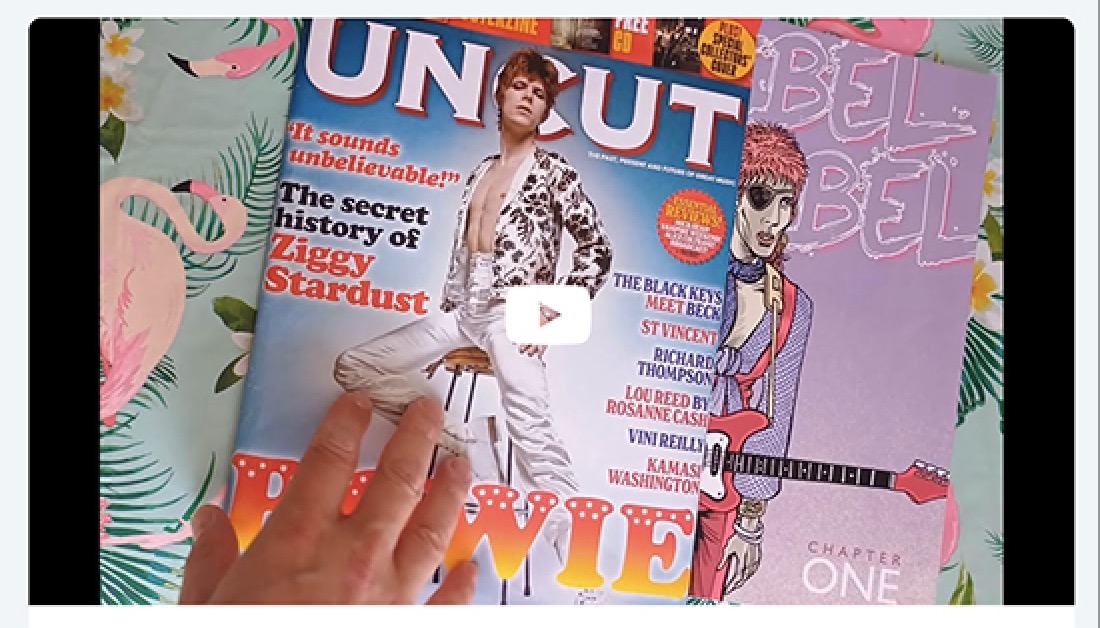
HILOBROW: Much enjoyed your readthrough of Uncut, and only in this light am I seeing a Kirby parallel even in Arnold Corns — i.e., the way Kirby had intended to hand off the Fourth World books to three other artists, then they ended up defining his art and directing his creative course ever after. Also had not known of the Rock ’n’ Roll Star set — how do they get through all 37 disks with no “Man in the Middle”??
CHRISOULIS: Indeed, in recent episodes of Rebel Rebel, Ken Pitt was preparing Bowie for a career as a Tin Pan Alley type songwriter for other artists and Arnold Corns was just another one of those projects (in his 70s collabs with Reed, Mott the Hopple, Dana Gillespie, and Iggy Pop he was really continuing this practice that Pitt pressed him to get involved in).
I think we’re really lucky that Kirby’s intention was not fulfilled, in that the Fourth World books could have been illustrated by Murphy Anderson, Sekowsky, or Aparo, who I like, but the dynamics and the details that make the books great would have been missed altogether. … Likewise, Bowie not recording Ziggy and leaving it to Arnold Corns would have resulted in a forgettable output. For starters, Freddie Burretti was a very bizarre choice for a frontman — almost self-sabotage!
HILOBROW: I feel like Bowie never stopped searching for a theatrical puppet-show to play with — an article that’s been eluding me (since I only ever read it while standing on a checkout line :-)) is an (I think) Elle feature from 1987-ish where he was still expressing enthusiasm about the chance he took with Glass Spider and how next he’d try mega-touring a similar revue of all new songs, essentially a stadium musical. Even though that’s the only such comment, and he was clearly talked out of it, I always thought that this is after all what Tin Machine was (just without the stadiums) — a short-run, all-new, self-contained musical drama (as embodied in what I feel was their one major work, that 9-minute omnibus video splicing all the first album’s songs together, a mini career arc of some future suit-punk band’s last stand before a marauding audience in this dystopian dive [“when the kids have killed the men”]… ).
I don’t think I’ve ever heard about Anderson, Sekowsky or Aparo for the Fourth World — I remember Romita Sr. for New Gods, Don Heck for Mister Miracle, and I don’t recall who for Forever People… it’s equally hard to imagine Heck being up to the drama of Scott & Barda, and Romita would have had some of Kirby’s pop-art power but not enough of his imagination on New Gods. Those other three artists seem like even worse matches (though Aparo might’ve risen to the occasion of a grittier Mister Miracle… maybe closer to the Mitch Gerads space-verité approach, just several decades sooner).
CHRISOULIS: I can try to look up the Elle interview in my archive. He did initiate the development of a Ziggy Stardust musical in the mid-90s after Q magazine, and others, kept on praising his glam era, making it less embarrassing for him. Britpop and 70s nostalgia was at an all time high, but after the Velvet Goldmine film debacle, where he pulled out last minute, he decided to shelve it. There’s been speculation that he could have reprised the role for a tour ala KISS, but it was not meant to be. To be fair, without the Spiders, and with his reorchestration and integration of trip hop drums to all his classics during this time, it might have been a train wreck — or at least very, very different.
I was just speculating on Sekowsky, Aparo and Anderson, based on DC’s roster at the time… I think anything drawn by DC mainstay artists would have ended up looking like Return of the New Gods, which was a massive eyesore!
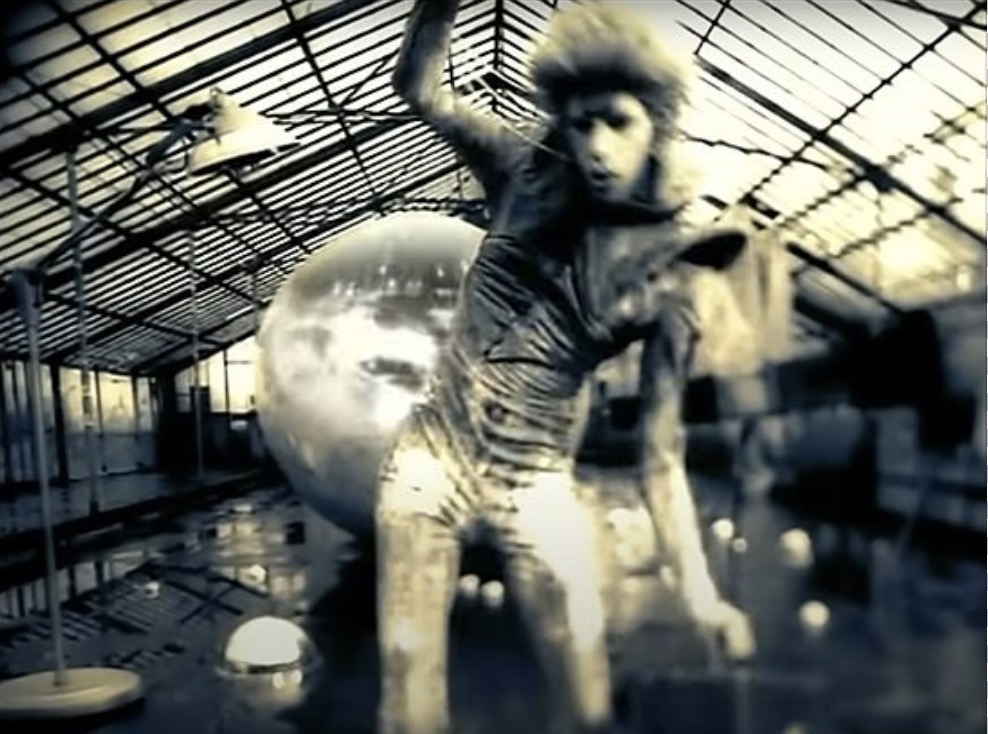
HILOBROW: It’s fascinating how Bowie would move up and down his own timeline, and be able to pivot at any point; I’ve read he contemplated reforming the Spiders c. 1981 (not far in time from when he did resurrect Major Tom and finally release the live Ziggy album), and I remember well when the Ziggy multimedia experience (musical/digital) made it into every interview c. 1999… then of course there was the (it seems to me surprisingly little-remarked) orphaned urchin Ziggy in the “Little Wonder” video, and the rather on-the-nose Glass “Spider” Tour (which I’ve long held was his just-a-minute-too-early ’70s -nostalgia bid, complete with that era’s top guitar-idol [Peter Frampton] swallowed whole as his sideman). I don’t think I’ve repeated it in this thread, but I see Velvet Goldmine in the same light as Watchmen — the creative variants forced from someone’s imagination when they’re forbidden to use someone else’s properties/likeness; in each case, for my tastes anyway, with better results than would’ve emerged otherwise.
Romita Sr., Heck and whichever creator I still can’t remember never did contemplate it, but Kirby asked; I don’t think they could conceive of it working, though I know I’ve read at least quotes from Romita (or maybe Evanier’s version of a quote from Romita :-)) that he was honored but just couldn’t risk it. Funny Kirby would propose such a thing, since he himself reluctantly rejected a similar proposition from Ditko a few years before; I suppose he just got more of a nothing-to-lose attitude over time.
CHRISOULIS: The several failed relaunches of Ziggy is indeed a research project in itself!
I absolutely agree about Velvet Goldmine; to me it’s the best Ziggy-era biopic. By breaking free from the officially sanctioned IP both the director and actors were liberated from the onerous yoke of faithful representation, culminating in a far more authentic output.
Wood, Ditko and Kirby (and “new” hotshot Neal Adams) could have hypothetically kick-started a proto-Image publishing house, but after the Mainline experience, I suppose Kirby was fed up with self-publishing. Having said that his mid-seventies return to Marvel is my favourite era, especially his Cap run.
HILOBROW: You have formulated my new favorite definition of the fidelity of interpretation!
Speaking of serial reversals and false starts, I seem to hear so many divergent stories of what happened with Bowie’s involvement with Velvet Goldmine… everything from just being asked to license some songs to complete the period picture, to it being a full-blown biopic (albeit not necessarily approved). I’m much further intrigued by you mentioning him pulling out at the last minute, I never knew it had gotten very serious. Curious since, Ziggy or no, it seemed that every new project in the last few decades of his life was always paired with something retrospective (a reissues series in the middle of Tin Machine, the Nothing Has Changed set midway through his Next Day/Blackstar renaissance, etc.). This makes me think he’d step out of Velvet Goldmine since, between [the album of ’60s remakes] Toy and a possible Ziggy reboot, he’d have everything in the retrospective column…
I agree that Eternals [from mid-seventies Marvel] was Kirby’s last masterpiece (or maybe first-to-last, since Silver Star is madly ambitious… )
CHRISOULIS: Oh I absolutely agree on [Bowie’s] last years being a retrospective tailspin (Toy being the most baffling project of all). Once Cool Britannia hit the scene, he was plagued by an onslaught of nostalgia-induced requests to rehash the past, both by reporters and Gen X fans that had never experienced the hype in the 70s.
There’s some info (and quotes) on the aborted Ziggy project here; whilst you can also access some info on Velvet Goldmine and his involvement here. Haynes has said that Bowie pulled out fairly late and the new supergroup songs had to be recorded at fairly short notice (that whole soundtrack is superb, so, again, it was all for the best).
Indeed, Eternals doesn’t get enough love. What also doesn’t get enough attention is how obsessed Kirby must have been in the 70s with UFOlogy, cryptozoology and ancient astronauts theory, which is apparent in his letter pages/columns in that era; I suppose most of humanity was equally obsessed. I remember my local public library in Melbourne in the 80s having a massive section on the occult, UFOs, cryptozoology, etc., suggesting that these crackpot books were accepted as legitimate scientific inquiry. I loved that section, but in retrospect it probably caused permanent brain damage/warped perspectives to a lot of folks :-). To think that people believe that the internet is to blame for everything!
HILOBROW: For me it wasn’t a tailspin, more like a metronome — for every leap forward, a flashback. Thanks for those Velvet Goldmine and Ziggy Replatformed links — the most sense I’ve ever seen made of both! The original music and video material for VG always strikes me as the work not of a stand-in Bowie but a parallel-universe Jobriath, where he had a bit more talent and taste… fitting enough as a model since Jobriath seemed to dwell on a fuzzy quantum line of something speculative and something that actually happened. A feature unique to Glam that I think about a lot is the way that all of its biggest stars didn’t exist — from Frank N. Furter to Hedwig, they are all fictional characters, including Ziggy, who was bigger than Bowie.
Speaking of aliens, I love the pseudoscience of the ’70s — proof is not needed when you pose everything as a question rather than a theory — was sacrifice of human hearts by Aztecs a misinterpreted emulation of Ancient Astronauts doing cardiac surgery?? (An actual question from, I believe, Von Daniken’s “Gold of the Gods” — not scientific, but a kind of brilliant :-))
CHRISOULIS: It’s funny that “Parallel-universe Jobriath”, and other glam units, were much bigger influences on Morrissey than Bowie, which can sometimes make my own graphic bio universe come across as ludicrous or unreliable!
When the Smiths split, Morrissey went through a strong glam-nostalgia phase, wearing makeup, see-throughs, etc. and bringing Ronson to the fore once more as his producer. He also sought out Jobriath for a co-headliner tour (!) only to find out that he died ten years before!
HILOBROW: So he tried to make Jobriath “his” Legendary Stardust Cowboy :-). Only fitting I guess that the non-Bowie glam stars were Moz’s bigger influence since they were, like him, hermetically sealed inside Britain (arguably even Jobriath, from my old town of King of Prussia, PA but probably better known in Blighty if at all).
CHRISOULIS:: **It’s hard to believe these days that the Chariots of the Gods doc was nominated for a documentary Oscar in ’71!
HILOBROW: Oscar nom, that is too good — train a camera on some Andean carvings and it counts as a documentary. (Though as a sociological document of what people in 1971 were prepared to believe, I suppose it’s spot-on after all.)
CHRISOULIS: What’s even funnier about Von Daniken is that his books were heavily rewritten by the Nazi Party’s newspaper editor Wilhelm Utermann who also wrote this 1940 Nazi classic.
HILOBROW: I don’t think I knew about the Nazi connection but I remember he wrote at least one of his books from prison (like a certain other bestselling author associated with the Nazi Party, come to that…)
Just confirmed by wiki that Von Daniken is still alive, too… I don’t know if it’s really possible to cheat death, but if anyone could defraud it, he’s probably the guy…
p.s. You have me thinking about Ziggy so much that it occurred to me the other day that “Rock ‘n’ Roll Suicide” not only features a direct homage to a Bacharach song, but is almost a tribute-composition to Bacharach, possibly unique to Bowie’s oeuvre (though I’ll have to do a more extensive mental inventory; certainly unique to the Ziggy album) — the way that it abandons verse-refrain structure after three rounds of the verse and indeed only two of the refrain and then progresses from one distinct theme to another three more times, never repeating, in these ascending plateaus of intensity seems very kin to the plot-twists of a Bacharach composition…
Even less apropos of anything, calling up “Ask” by the Smiths on my car computer-radio the other day made me wonder if that song is the ground zero of Morrissey’s fandom among Mexican-Americans — it does sound like the closest thing Manchester’s ever had to a Norteño, the “north” part being a gift-pun from God…
CHRISOULIS: That’s a fair breakdown. “Rock N Roll Suicide” owes a lot to Jacques Brel’s “You’re not alone” (even nicked a lyric there). Bowie was absolutely obsessed with Scott Walker (who covered Brel) but also the musical Jacques Brel Is Alive and Well and Living in Paris, which he saw in the summer of 1968 multiple times (I’ll soon be covering it)!
HILOBROW: That’s a great puzzle-piece to learn of — to more than one puzzle; I had not known of Elly Stone but I sense a big influence on Buffy Sainte-Marie. I love how Bowie would implant not just another singer’s style but their set of embedded influences too (something which he backhandedly complimented Numan on later).
CHRISOULIS: Mexican Americans’ obsession with the Smiths and Moz is a real puzzle. I think it has a lot to do with their rockabilly looks, black quiffs and the ranchera style finger-picking on Marr’s guitar. I’m amazed that they stuck with Moz after his 2010ish press quotes. He seems to have quieted down a bit lately, thankfully!
HILOBROW: Ah, your insight into Marr’s technique is another sound theory! It’s easy for me to think that Moz’s archetypal Englishness and pale tremulous persona make him an exotic artifact of the declining Global North, though my mature hostility to him may be influencing that; suffice it to say that his cultural distinctness is something that people very different from him may respond to, even though he scarcely extends the same kind of courtesy.
CHRISOULIS: Absolutely. As discussed in Tales of The Smiths, at the inception of The Smiths, Moz and Marr’s influences were anything but Northern. Their deceptive romantic appearance veiled their true 60s girl band and punk/post-punk influences. Once one hears of Rourke and Marr’s pre-Smiths funk band, they truly understand Marr’s fast riffs and Rourke’s percussive bass. But funk and Smiths are two words that you’d never put together.
And who would have thought at the time that the New York Dolls influenced bookish Morrissey more than anyone else? As he studied and digested their paradigm for years, he knew exactly which buttons to push when presenting himself to the public.
HILOBROW: As early as the loops and serrated punky guitars of the Stephen Street era it felt like a fully cataloged bag of tricks that had been time-released to expose…
[There follows a several-month gap in which Con delivers his PhD thesis and goes on holiday, and Adam finishes a graphic novel script and adopts a dog…]
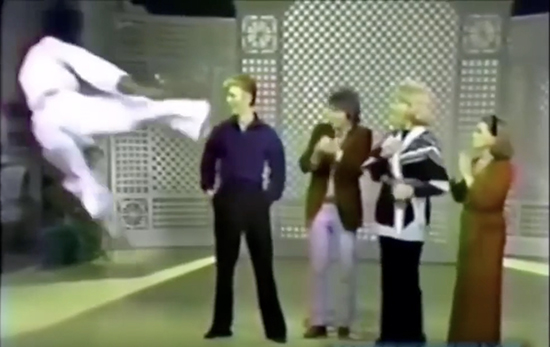
HILOBROW: Cheers Con, hope your time off was restorative, I know I took more time out from this conversation but continued to look in… ever futher insights to be harvested from not just tech’s but time’s capacity to rewind and stop the tape, i.e. your excavation of Bowie’s martial-arts interest — his history of and readiness to violence is something that has never computed with even his deepest fans I think, even though fights could be the most signifcant raw material of his medium, like the punch that created The Frozen Eye… reading the karate stories put the Let’s Dance era’s boxing motif into better perspective for me.
Still loving the subtle scope of your panoramic technique; a panel like the Beatles’ trip to India has that classic round-the-world newsreel feel while the one showing the quiet landscape of the Intimate Theatre/church grounds in a single frame still feels like a time-lapse composite of history given the life-cycle the text describes for that site. I’m curious, is your current work in some ways a pioneering form of Patreon-as-medium in that the biographer’s method of researching and comparing, compiling and re/considering so aligns with the process-revealing essence of that type of platform?
CHRISOULIS: Thanks for the kind words about the panoramic technique that I somehow insist on using all the time. Whilst in Greece, I bumped into some art books that I was reading some decades ago, whilst rummaging through old art and comics, and I remembered being fascinated with Alphonse Mucha’s Slav Epic and thought it might also have subconsciously instigated this practice. This panoramic technique Mucha used to narrate the Slav Epic is mostly rooted in the depiction of biblical scenes from Greek Orthodox iconography/frescoes, which I have also been exposed to from a very, very young age, that has been passed onto the Slavonic churches.
Re: Patreon and biography. Patreon is being used a lot to crowdfund history projects/podcasts (ex. The History of Byzantium, which I am a fan of), but I am unsure of any biographers using the platform, let alone graphic biographers. I’m not sure that many researchers realise the medium’s capacity to communicate longform biographies in small doses. Or if any biographers are prepared to dedicate a decade on a single subject. Biographers (and graphic biographers, like Reinhard Kleist), tend to spend a limited amount of time on a certain subject, get the book published and then move onto the next subject. I’ve certainly worked on past graphic biography projects like Tales of The Smiths, which was also serialised over a few years, but now that I am in full control of the output, and there are no pagecount restrictions, it feels like I am treading in new territory. The traditional printed tome that one has found in a bookstore for the past 100+ years is still the epitome (excuse the pun) of biographical research output. This “unlimited” time (unless I croak it at some point) that I have to unravel Bowie’s formative years episodically online allows the expansion of the narrative into multiple organic tangents that sometimes feel like meandering “newsreels”, as you mentioned; however, slowed down to the point that I have now, where I am almost narrating Bowie’s life from week to week in 1968, helps enrich the reader’s experience from a one-off reading to a continuous involvement; just as I instigate a method-writing approach, which I think I explained a while ago, in which I live and breathe alongside this ongoing project/subject, I hope that readers immerse themselves in a method-reading practice (at least that’s my theoretical approach and, as of late, intent).
HILOBROW: We think of artists who rose from adverse and obscure beginnings as “inventing themselves,” but that often refers more to the story they put together after the fact of who they are, where your biographies go back to uncover the events and influences that created them. So you end up with detailed and epic accounts that conclude at what most people would think of as the start. Does cracking that code complete the story for you? Closing the circle with the part of the story we all already knew? (Though filling in the past can also effectively change the story we thought we knew…)
CHRISOULIS: My experience (or fixation) with unravelling the formative years of pop stars is a self-devouring ouroboros of sorts. The reader that hasn’t been paying attention all these years (as well as the audience that is unaware of the text itself) will keep asking if I will narrate Bowie’s entire life and how long it will take; however, the reader that is clued-in understands that it’s all happening at the same time. By the time I reach 1970/71 I will have made so many connections to the origins of Ziggy Stardust that it will feel superfluous to narrate Bowie’s glam years; should I decide to do so, I would have to take a radically different/non-linear approach to make things a bit more interesting.
HILOBROW: That’s a fascinating compositional provenance for your technique, I can definitely see it but, as with Bowie’s best influences, they are woven in and absorbed so elegantly that they only occur to the observer long after enjoying the current work or when pointed out. A thoughtful and rewarding answer about Patreon & biography, I can tell you’ve been investigating that relevance for a while! Very true about ending at the beginning, and Bowie’s oeuvre itself was an ouroboros with many loops; you’ve almost got the entire career encoded by 1970 — Walker’s Scott 3 album blueprints every vocal mannerism (other than Newley, Dylan or Bolan) that Bowie will use for the next 8 years, and then the persona-change in Scott that “Heroes” sparked will guide Bowie off and on from 1993 to his death (most decidedly “on” for The Next Day and Blackstar)…
CHRISOULIS: In fact, I’m digging in, as we speak, on a series of new findings about an even more intimate Walker-Bowie connection (they shared the same girlfriend for a while who clued him in on Jacques Brel)! Soon, at the same REBEL REBEL time, on the same REBEL REBEL channel! :-)
MORE POSTS by ADAM McGOVERN: OFF-TOPIC (2019–2024 monthly) | textshow (2018 quarterly) | PANEL ZERO (comics-related Q&As, 2018 monthly) | THIS: (2016–2017 weekly) | PEOPLE YOU MEET IN HELL, a 5-part series about characters in McGovern’s and Paolo Leandri’s comic Nightworld | Two IDORU JONES comics by McGovern and Paolo Leandri | BOWIEOLOGY: Celebrating 50 years of Bowie | ODD ABSURDUM: How Felix invented the 21st century self | KOJAK YOUR ENTHUSIASM: FAWLTY TOWERS | KICK YOUR ENTHUSIASM: JACKIE McGEE | NERD YOUR ENTHUSIASM: JOAN SEMMEL | SWERVE YOUR ENTHUSIASM: INTRO and THE LEON SUITES | FIVE-O YOUR ENTHUSIASM: JULIA | FERB YOUR ENTHUSIASM: KIMBA THE WHITE LION | CARBONA YOUR ENTHUSIASM: WASHINGTON BULLETS | KLAATU YOU: SILENT RUNNING | CONVOY YOUR ENTHUSIASM: QUINTET | TUBE YOUR ENTHUSIASM: HIGHWAY PATROL | #SQUADGOALS: KAMANDI’S FAMILY | QUIRK YOUR ENTHUSIASM: LUCKY NUMBER | CROM YOUR ENTHUSIASM: JIREL OF JOIRY | KERN YOUR ENTHUSIASM: Data 70 | HERC YOUR ENTHUSIASM: “Freedom” | KIRK YOUR ENTHUSIASM: Captain Camelot | KIRB YOUR ENTHUSIASM: Full Fathom Five | A 5-part series on Jack Kirby’s Fourth World mythos | Reviews of Annie Nocenti’s comics Katana, Catwoman, Klarion, and Green Arrow | The curated series FANCHILD | To see all of Adam’s posts, including HiLo Hero items on Lilli Carré, Judy Garland, Wally Wood, and others: CLICK HERE

